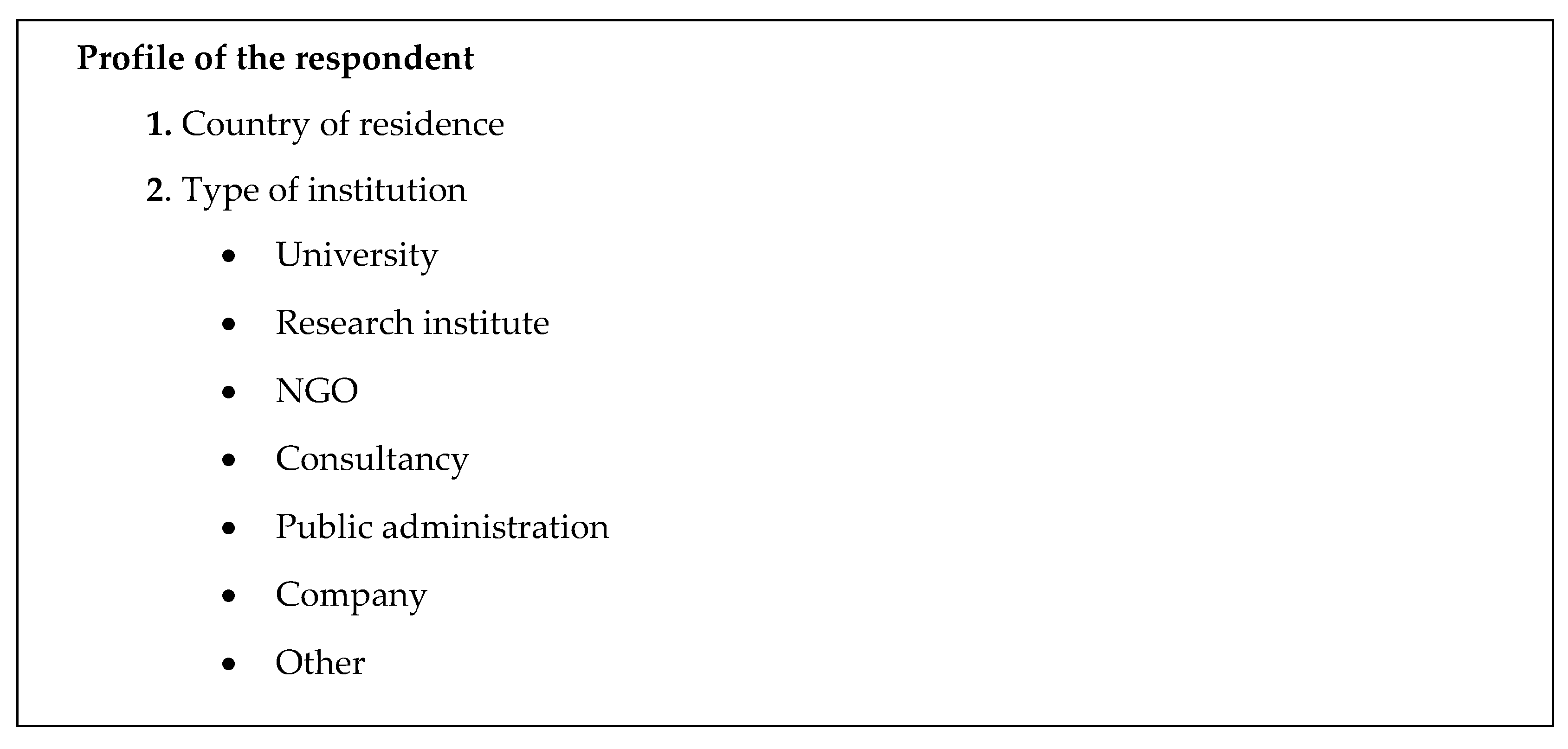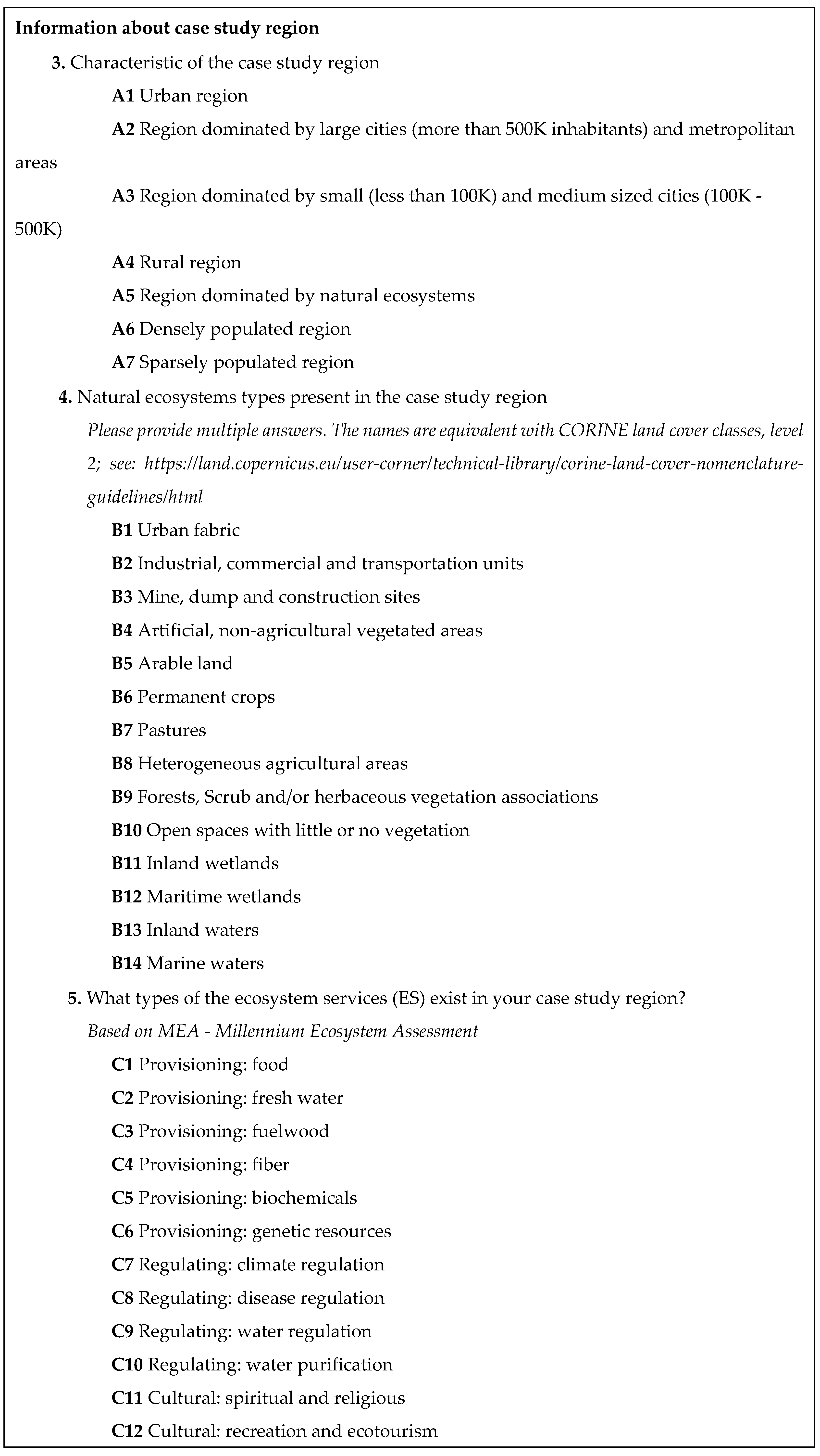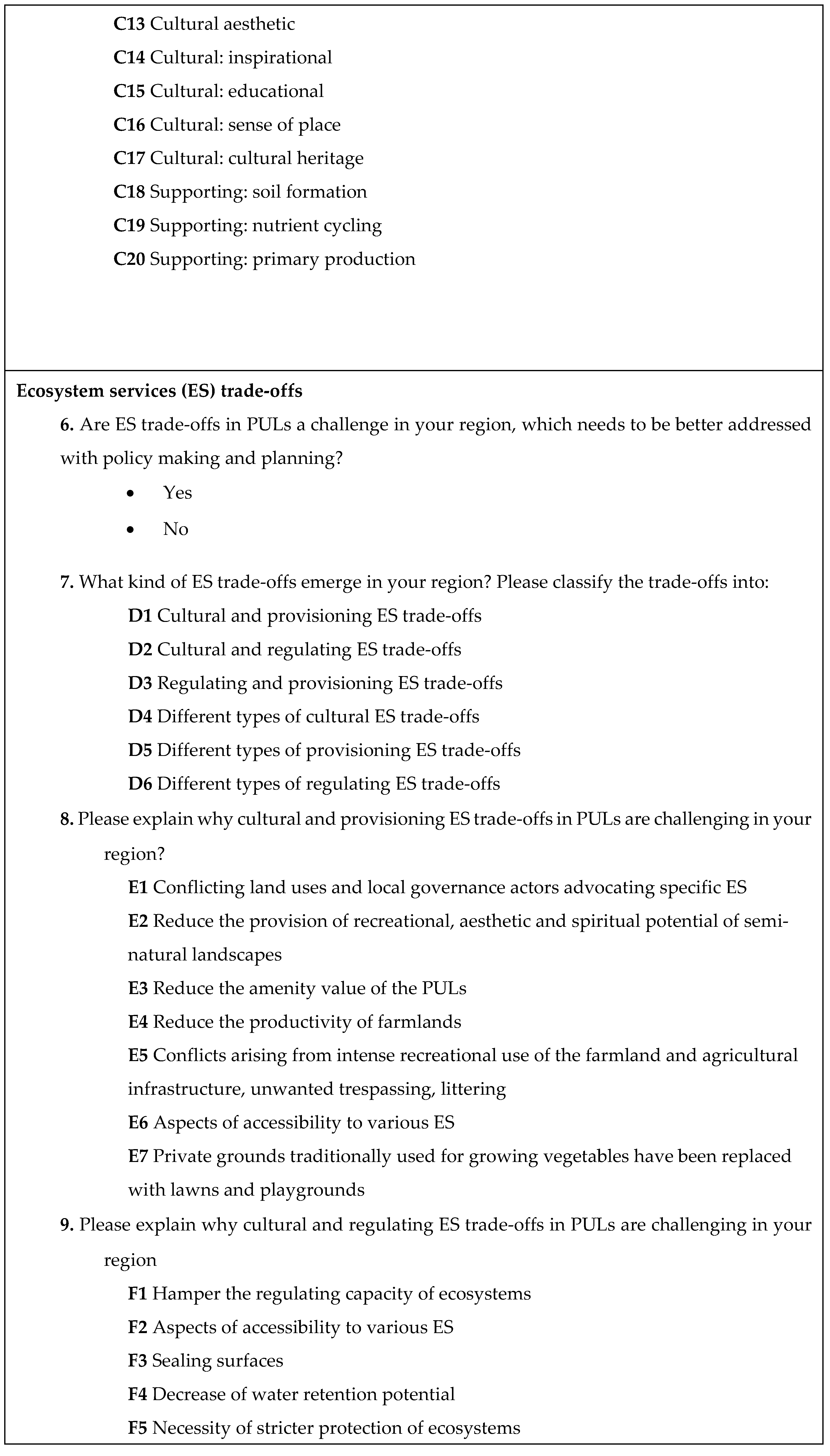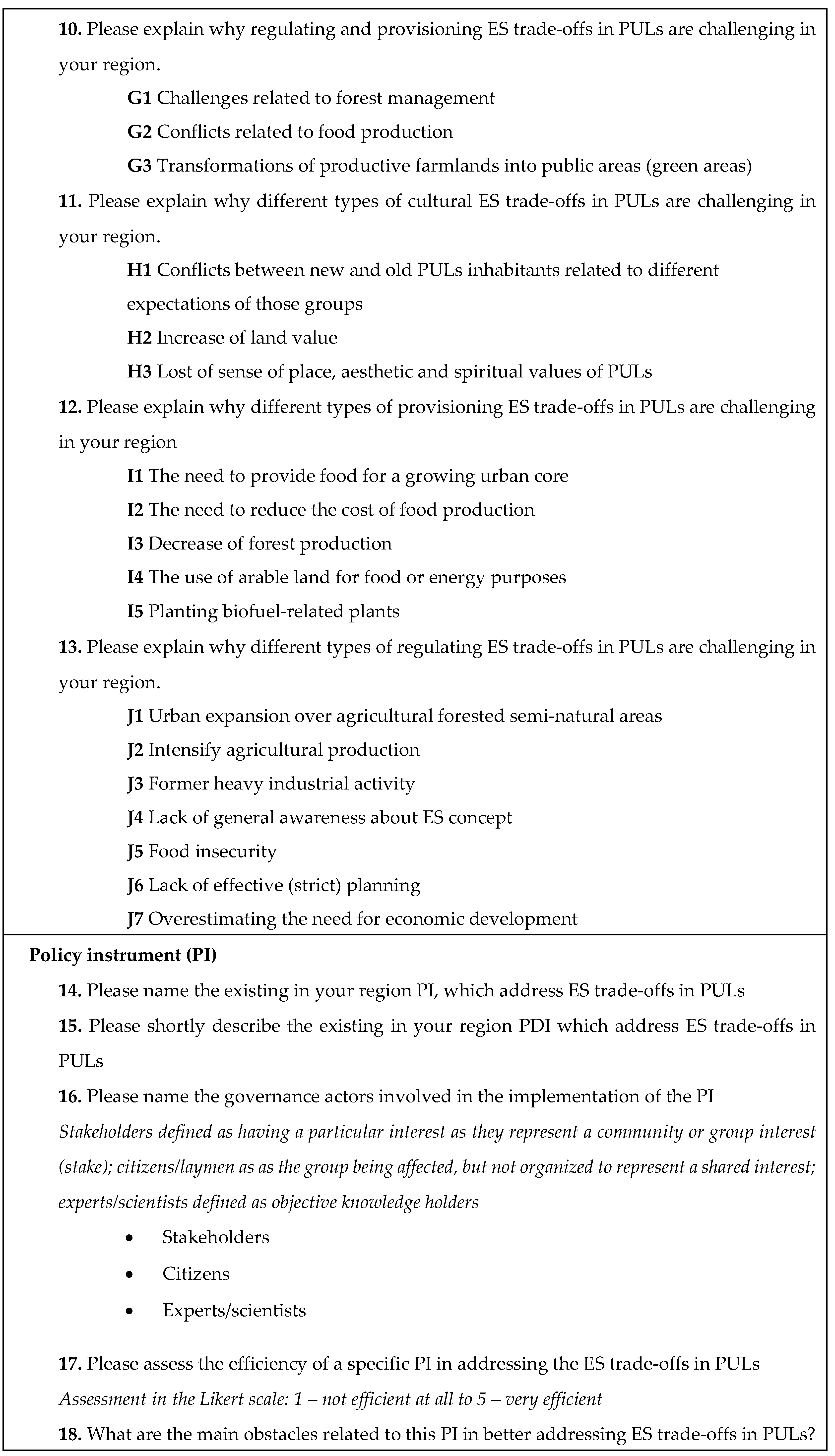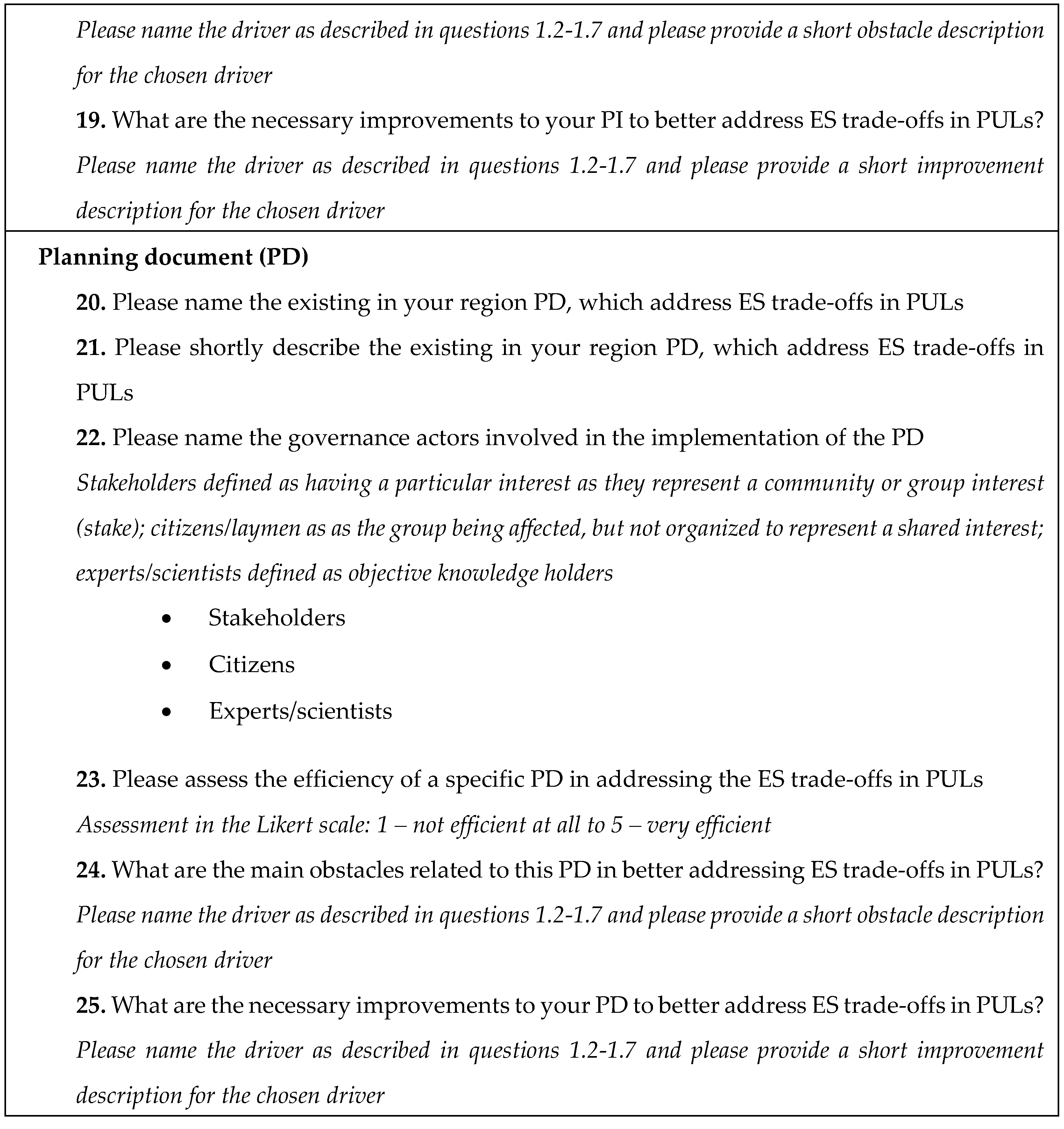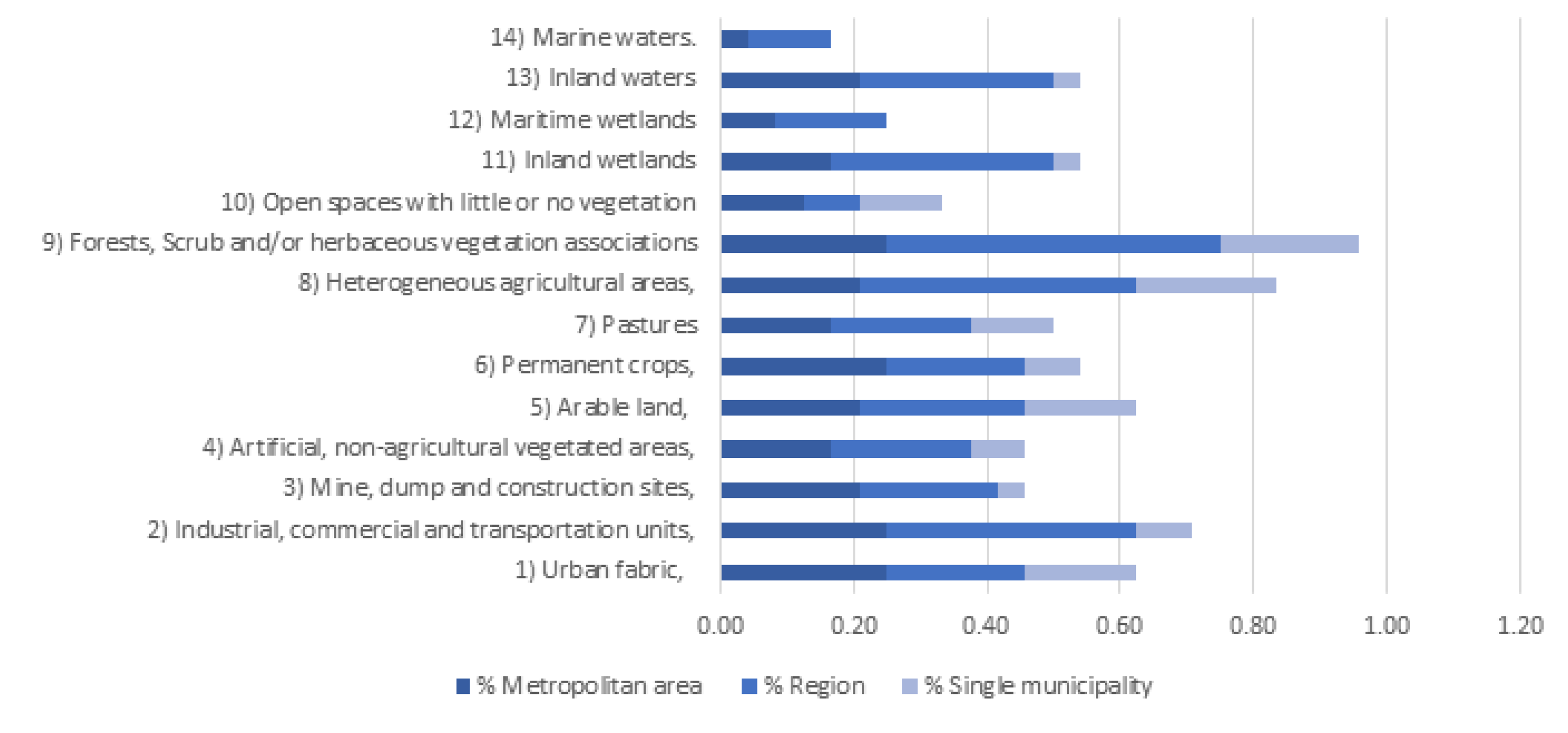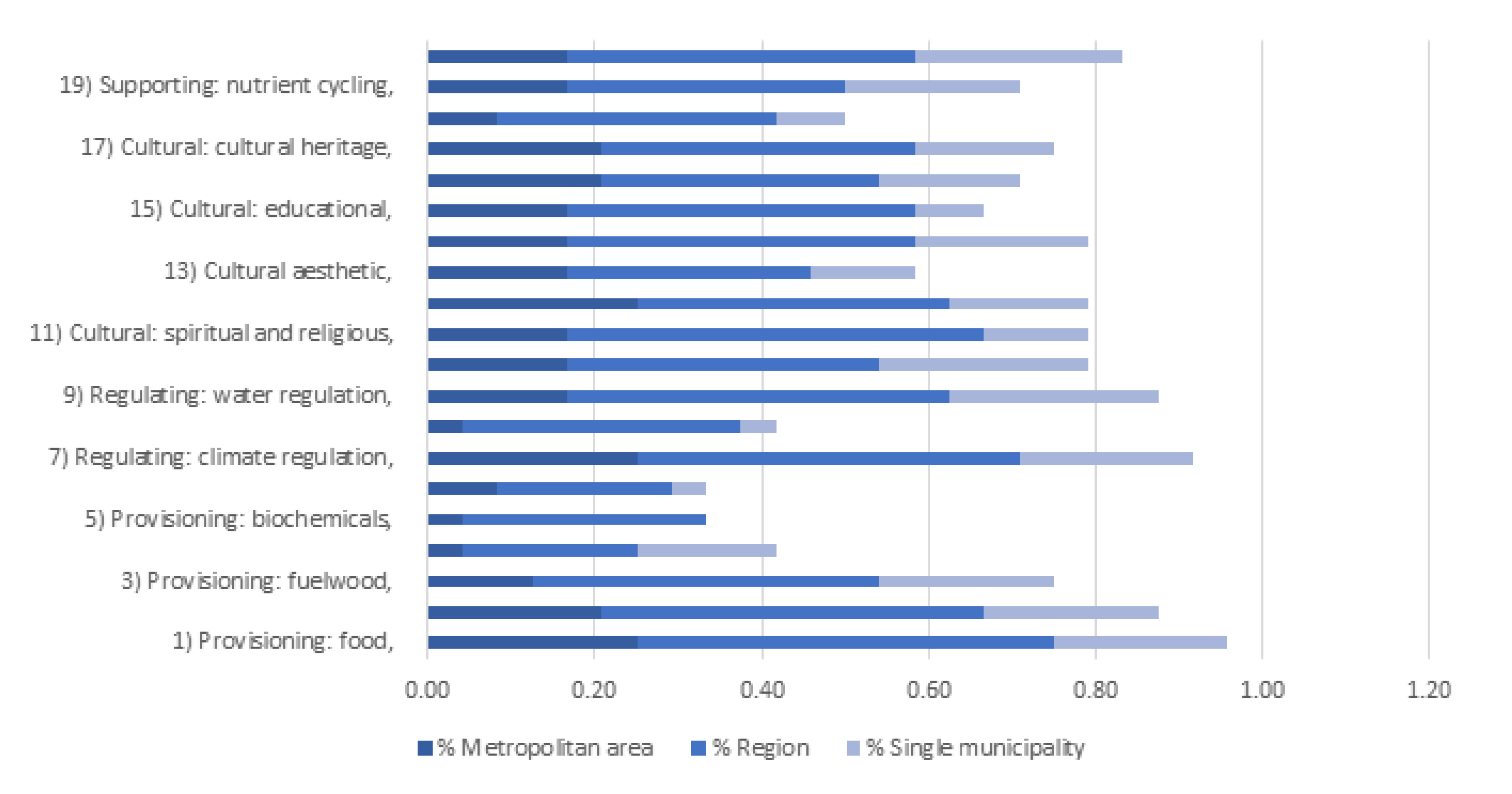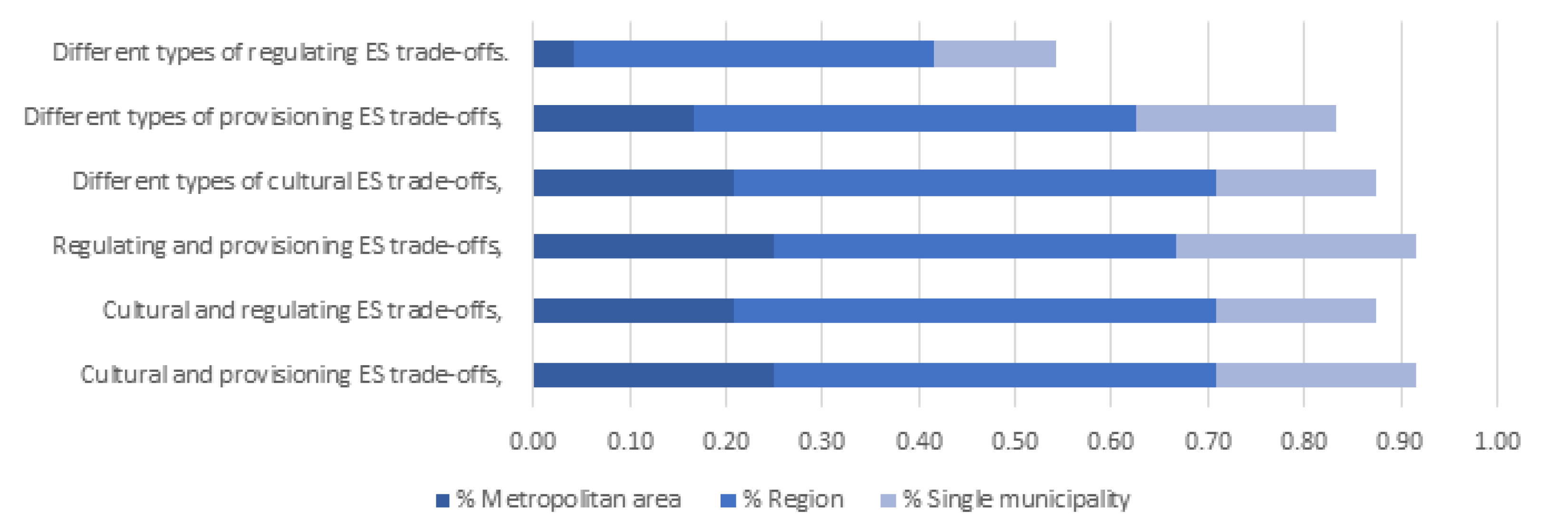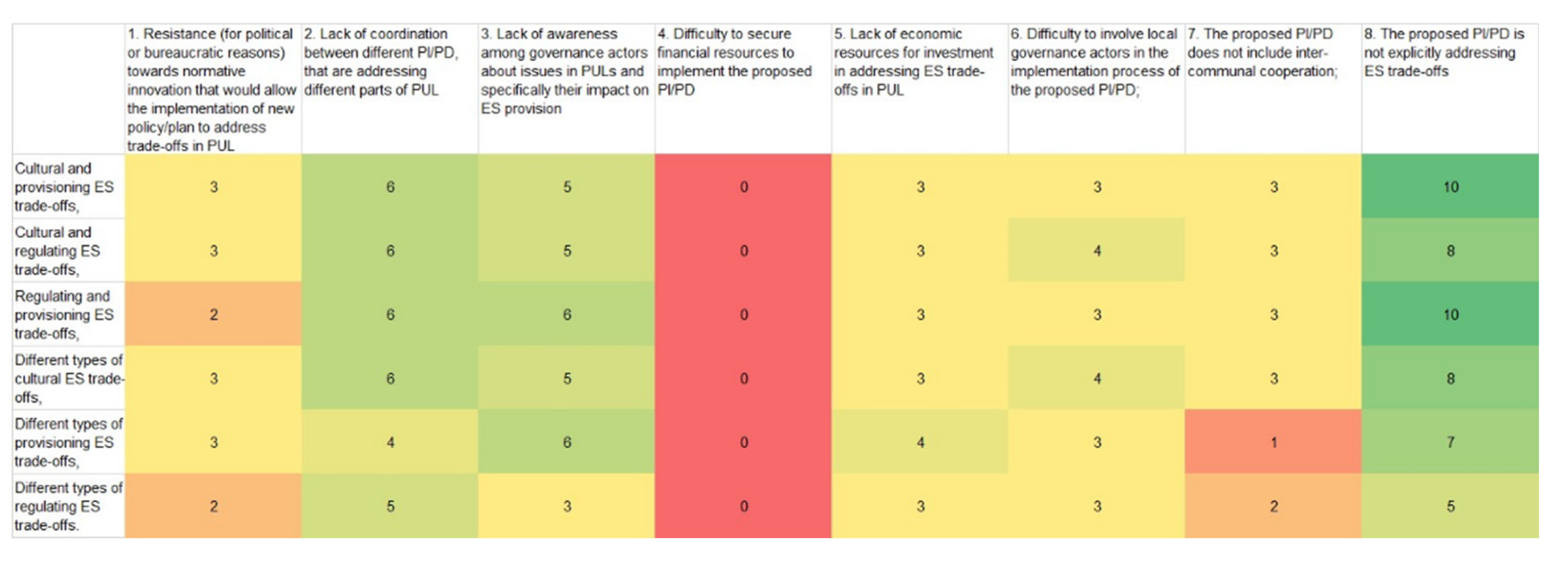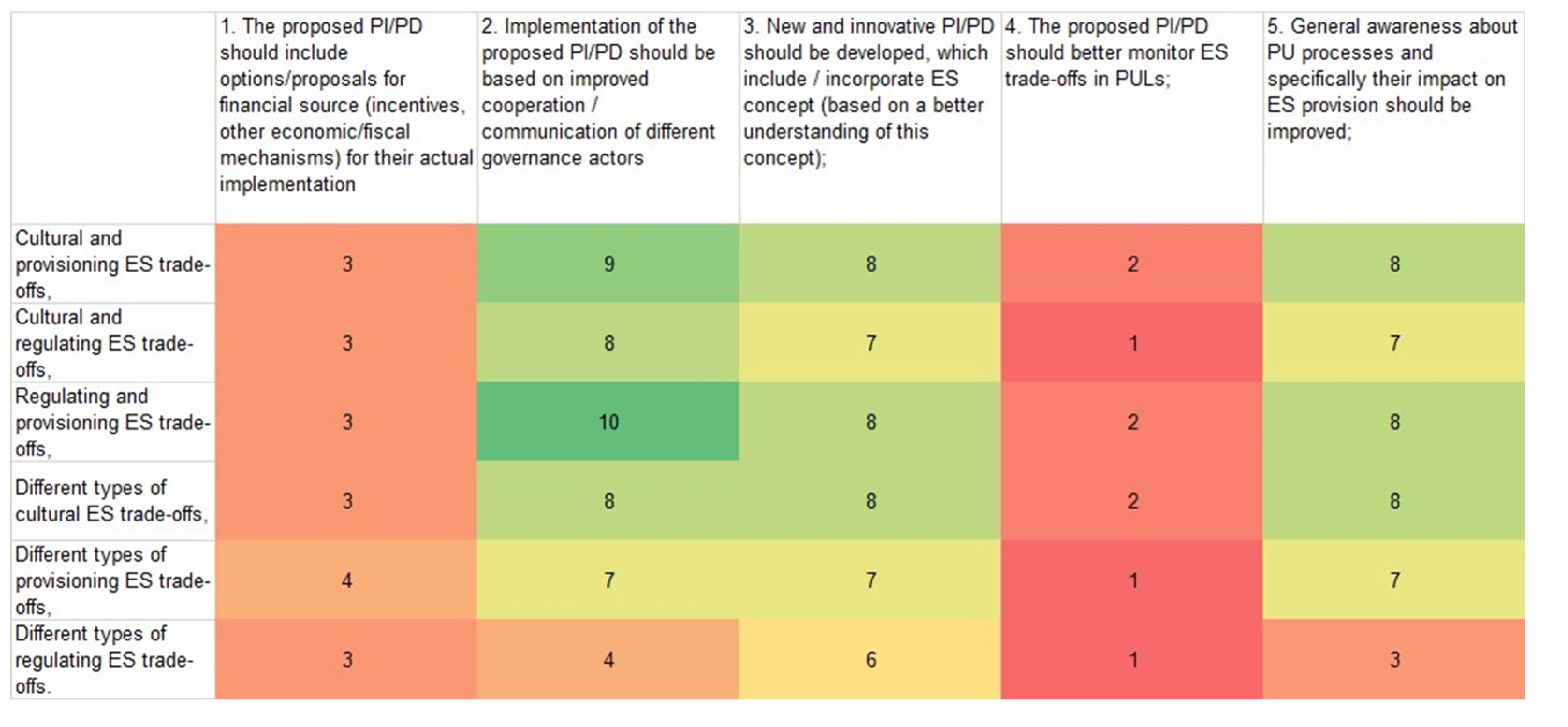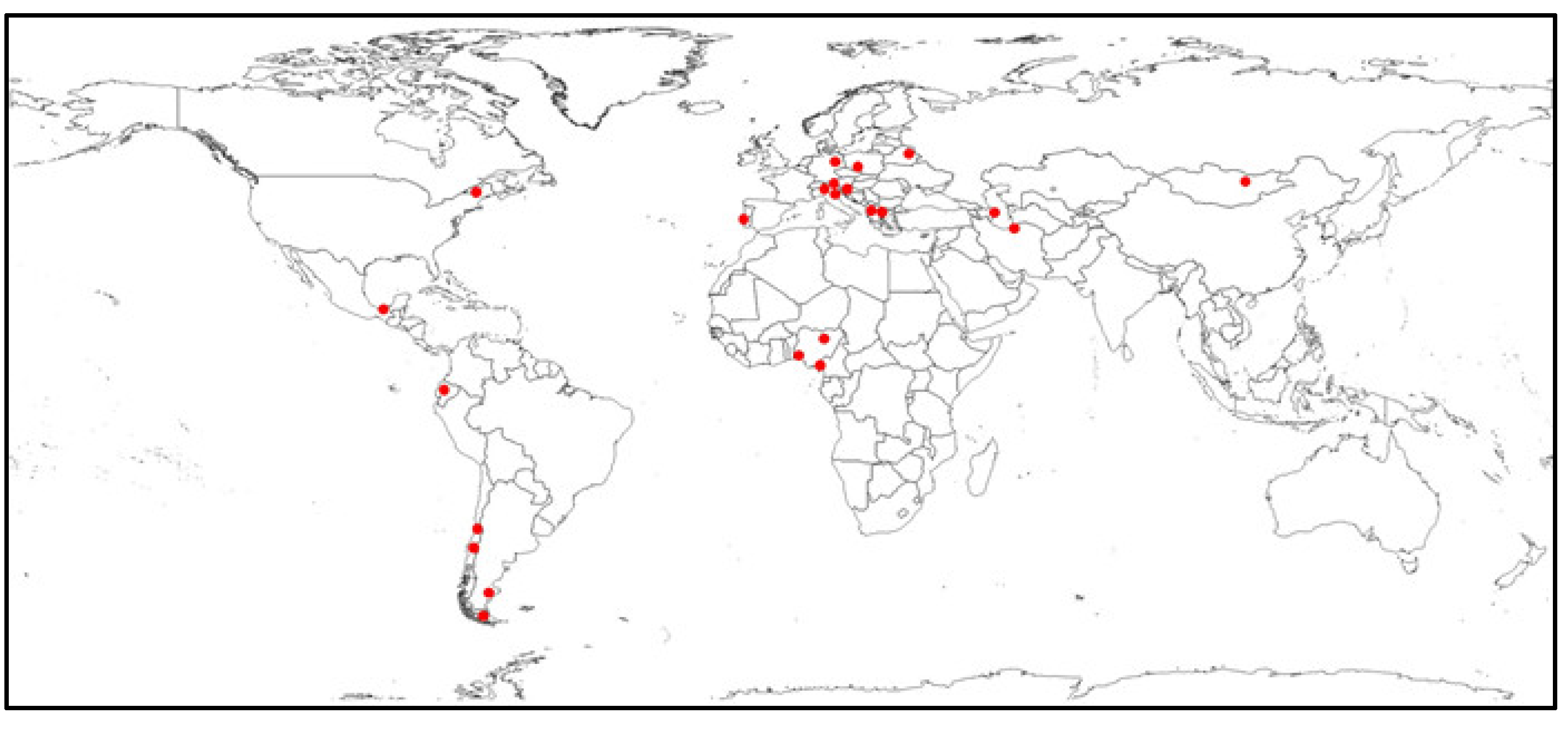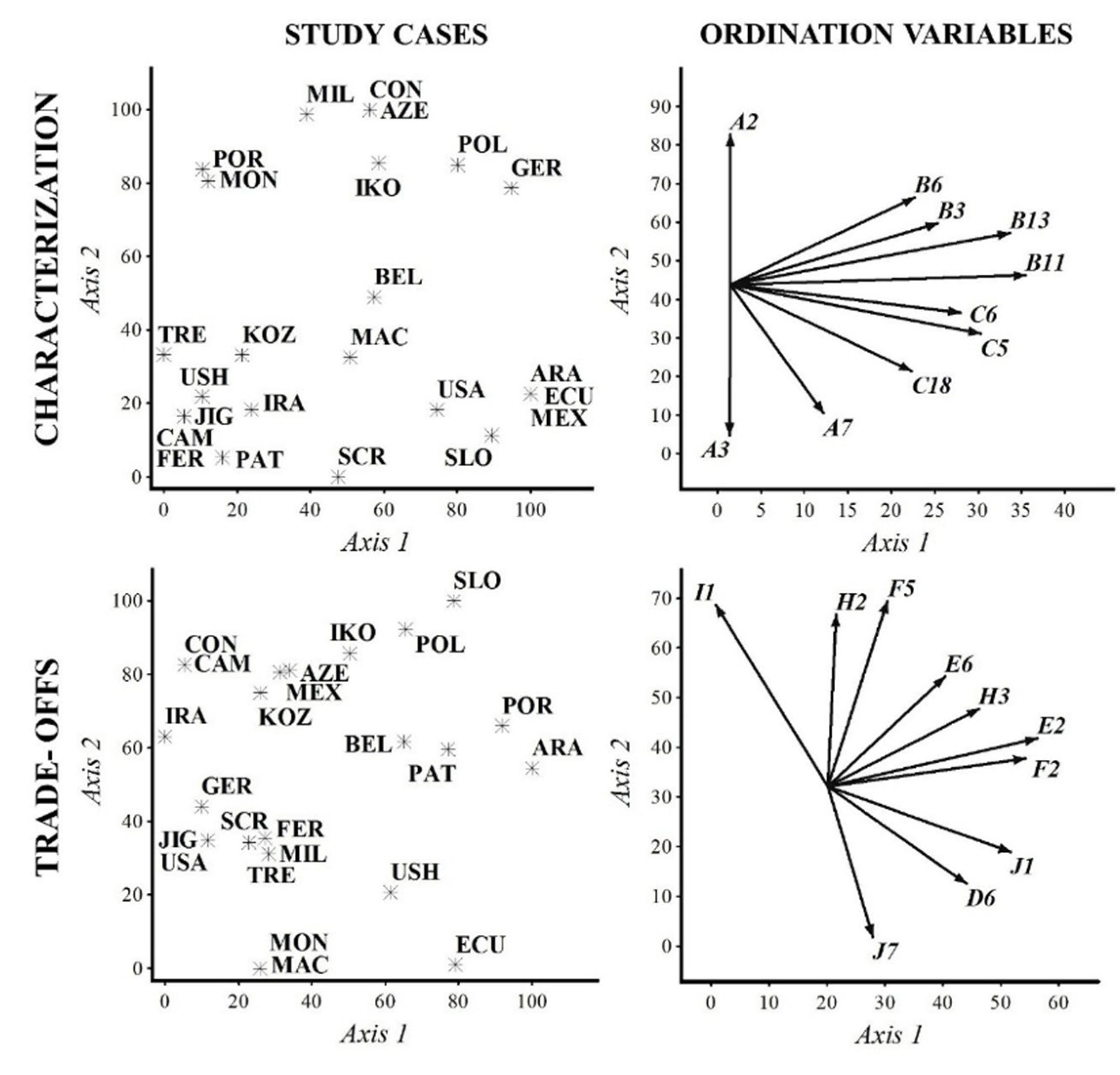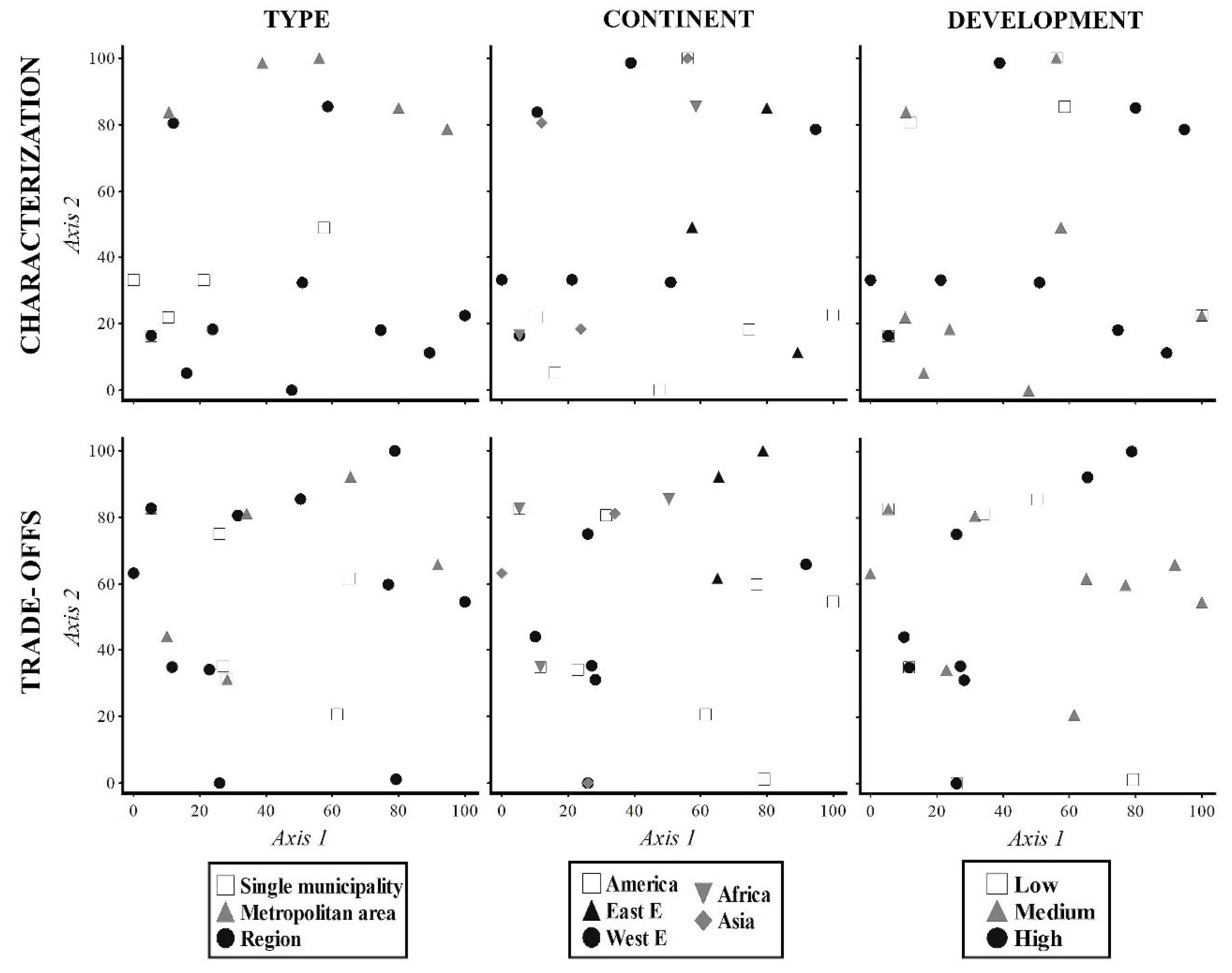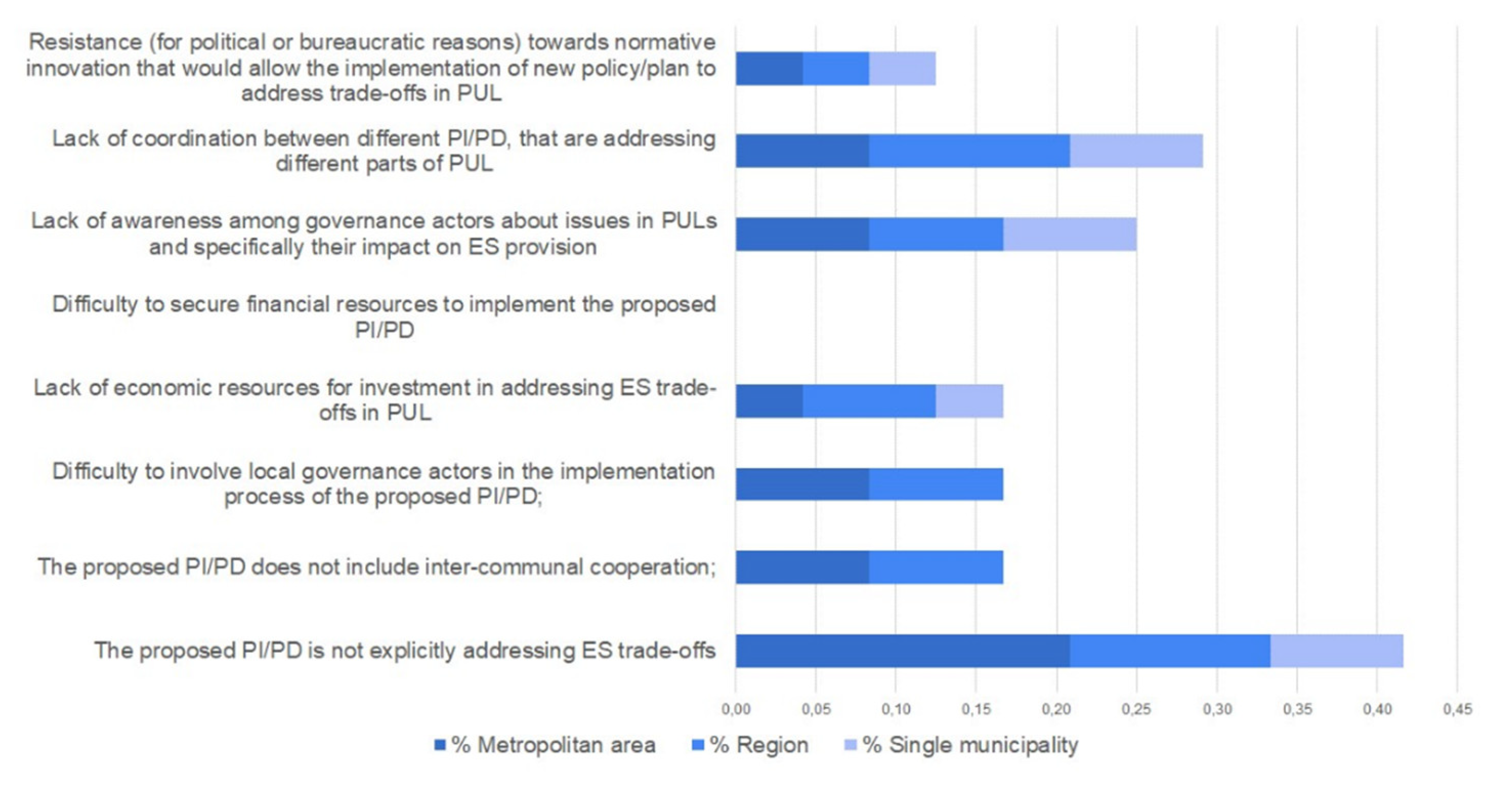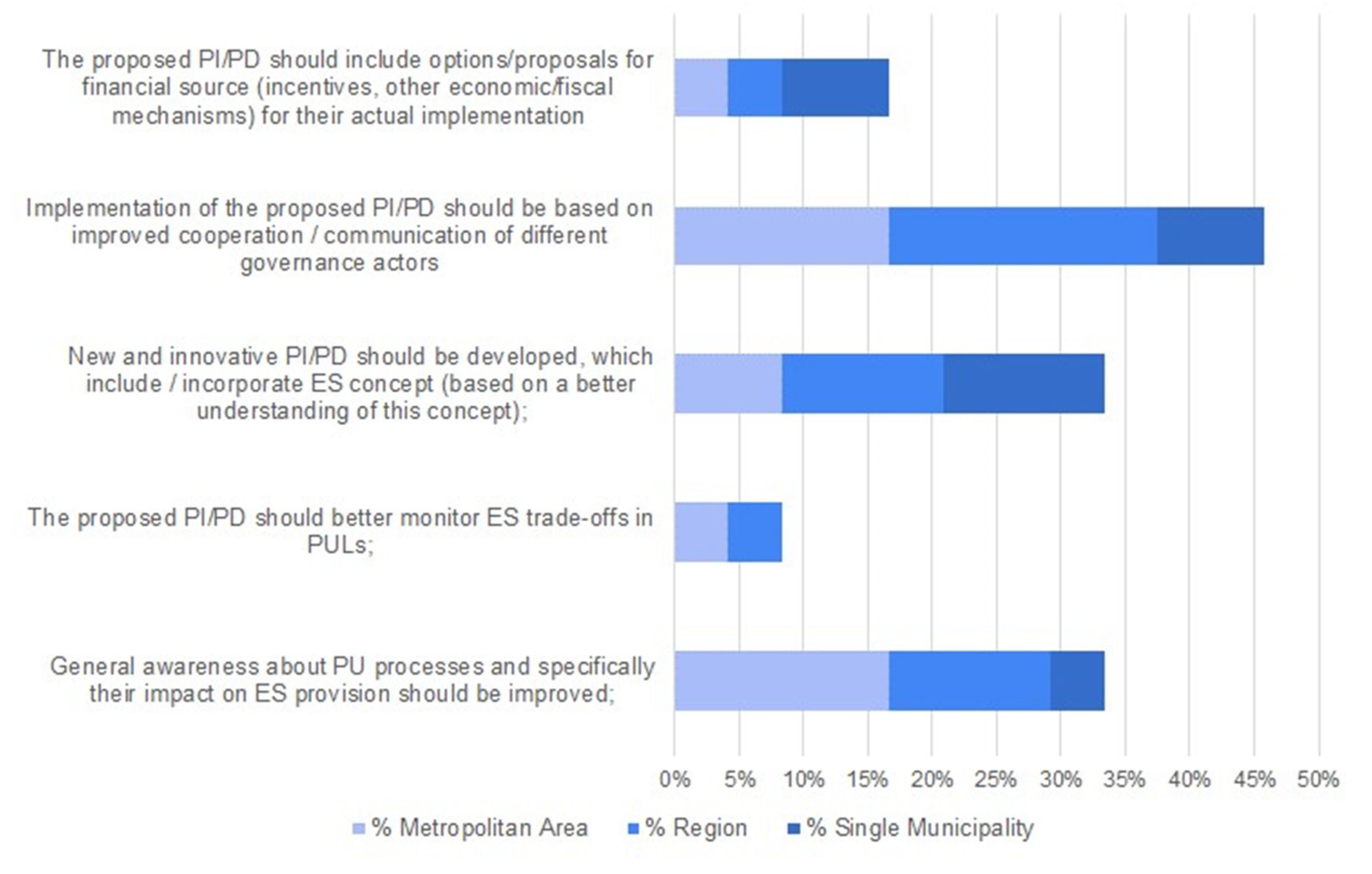1. Introduction
1.1. Ecosystem Services Trade-offs in Peri-Urban Landscapes
Ecosystems are often modified to enhance the provision of specific services [
1]. Peri-urban landscapes (PULs) are examples of specific areas where land-use changes occur in a very dynamic way, thus producing modifications in the provision of services of the related ecosystems. PULs are wide portions of man-modified landscapes embedded in a (semi)rural context [
2] in a continuous spatiotemporal manner and often within large metropolitan regions [
3]. PULs are characterized by low density urban fabric and different types and mix of land-uses and urban services, including residential, commercial, industrial, farmlands and semi-natural areas and ecosystems [
4]. Such a mixture of land-uses is the result of dynamic socio-ecological changes, obtained faster than in other urban contexts and at usually higher extent of soil consumption, with many environmental externalities generated [
5,
6]. If not correctly planned and or man-aged, such rapid changes can often lead to trade-offs in the provision of ecosystem services (ES). ES trade-offs represent a situation, where one ES decreases as a result of increase of another ES [
7]. Very of-ten ES trade-offs occur in the situation, where two types of ES support different objectives [
1]. Specificity of ES trade-offs depends on the context, were they are identified [
8]. Trade-offs also occur when there is a difference between the supply and demand for certain services, leading to an unbalanced or unfair distribution of services to people [
9]. So far ES trade-offs have been studied from different perspectives over the past decades, for example focusing on categories of spatial, temporal, reversible, and among-service trade-offs [
10].
1.2. Drivers and Management of Ecosystem Services Trade-offs
A driver is a factor related to human management activities, which affects ES [
1]. Specifically, many ES trade-offs are driven by land use and land cover changes [
10] or urbanization processes [
11]. These process-es have a significant relevance in peri-urban contexts, due to the dynamic changes in land use and land cover. Drivers can change dynamically in time, especially for transitioning landscapes, like PULs. Thus, divers of ES trade-offs need to be analyzed in a specific time context and cannot be generalized over time. Ignoring the history of a landscape and related ecosystems might lead to an increase trade-off, instead of synergies among ES [
11]. Failing to recognize and address drivers of ES trade-offs could lead to inequalities in ES provision and, to some extent, irreversible damages for some ecosystems [
12]. Identifying potential trade-offs occurring in a certain landscape enables the design of effective management decisions aiming to minimize social conflicts and possible environmental issues [
13]. Nevertheless, ES trade-offs are still a problematic issue for policy makers and planners, mainly due to difficulties in assessments of relations among ESs [
14], even if promoting synergies among ES trade-offs needs to be one of the priorities of current land-use policies [
15]. Moreover, recent research shows that instruments for environmental management and policy making could be per-se one of the ES trade-offs drivers [
10], classified as socio-ecological group of drivers [
1]. In particular, political practices, socioeconomic incentives and technological progresses are the set of drivers potentially generating ES trade-offs [
16]. The interaction of different administrative and hierarchical levels of governance actors could be also seen as one of important drivers of ES trade-offs [
17], as specific services increased for higher administrative level can be followed by loss at more local level.
1.3. Policy Making and Spatial Planning in Peri-Urban Landscapes to Address Ecosystem Services Trade-offs
When looking at PULs, important ES trade-offs are related either to agricultural activities [
18] or recreational activities, that both intensively emerge in such landscapes [
19]. Although some cities develop different policy mechanisms to address sustainable food production in PULs and reduce ES trade-offs, the efficiency of these policies is either difficult to assess or rather low [
20]. The integration of top-down and bottom up governance approaches has been also advocated [
4], e.g., to achieve such a goal, it is important to address influential users and context setters, as those actors are often responsible for ES trade-offs [
8] and to implement more efficient spatial planning measures in PULs [
20]. Overall, spatial planning measures are needed to support the improvement of rural-urban relationship, representing the most typical peri-urban feature [
20].
1.4. Research Gap and Research Aims
In this paper we want to look on real world examples of ES trade-offs in PULs identified in 23 case study regions including PULs, with particular reference to normative instruments, policies and plans that try to tackle some ES in different geographical contexts. To this aim, we performed a detailed survey with regional experts of ES, to get knowledge related to policy making and spatial planning for the specific con-text of PULs. More specifically, this paper has the following specific aims: (i) To characterize the case study regions containing PULs and analyze the ES trade-offs, identifying possible similarity patterns among them, according to the administrative level, continent, and eco-nomic development level; (ii) to describe drivers of peri-urban ES trade-offs at each case study region; (iii) to characterize obstacles, concerning to how ES trade-offs in PULs are addressed by policy instruments and spatial planning documents of each case study region; and (iv) based on the case studies analyzed, to describe possible improvements on how ES trade-offs could be better addressed by policy making and planning in PULs.
2. Materials and Methods
To facilitate our research aims we implemented an on-line survey. Such a qualitative research method has several advantages related mainly to its flexibility [
21], as it can reduce interview bias, simplifies data collection and processing and increases convenience of respondents [
22]. Other ES related studies have successfully implemented this method to display advantages and risks of using ES concept in participatory planning [
23] or to discuss about academic teaching of ES concept [
24]. The survey was forwarded to members of the following networks: International Association of Landscape Ecology (IALE), Global Land Programme (GLP), and IUFRO Landscape Ecology Working Party. We also used our personal scientific networks to contact scientists and peers working in the field of governance, planning and ecosystem services in peri-urban contexts. The survey was forwarded by the notice of data protection and explanation of the survey objectives and contained 25 questions, 17 close ended and 8 open ended. Questions were organized into six following main sections: (i) profile of the respondent, (ii) information about the case study region where PULs are located, (iii) ES trade-offs, (iv) ES trade-offs drivers, (v) policy instrument, and (vi) planning document. First section allowed us to gather general information about our respondents’ profiles. The second section contained questions about the case study region where PULs are located, that beside basic statistical data, show details of the natural ecosystems’ types and types of ES present in the region. Section three allowed us to gather information about ES trade-offs in the analyzed PULs. The following pairs of ES trade-offs were analyzed: (i) cultural and provisioning ES trade-offs, (ii) cultural and regulating ES trade-offs, (iii) regulating and provisioning ES trade-offs, (iv) different types of cultural ES trade-offs, (v) different types of provisioning ES trade-offs, and (vi) different types of regulating ES trade-offs. Section four contained closed ended questions about drivers of ES trade-offs, where answers were pre-defined based on other studies [
4]. Section five of the survey collected data about policy instruments, while section six was about planning documents, that were so far addressing ES trade-offs in the analyzed case study regions. Open-ended questions were about: (i) obstacles related to a policy instrument / planning document to better address ES trade-offs (question #18 and #24, and (ii) potential improvements to a policy instrument / planning document to better address ES trade-offs (questions #19 and #25). The answers to these open-ended questions were content analyzed and the specific topics emerged from this analysis were included in the results. Finally, all closed ended questions’ answers were binary coded: “1” is detecting a positive answer to a question (e.g., a selection of an available answer option by a respondent), while “0” is detecting a negative answer to the question (e.g., a lack of selection of an available answer option by a respondent). Detailed questions addressed in this survey together with their codes are presented in
Table A1.
Descriptive statistics were used to characterize the analyzed case study regions and PULs. Answers pro-vided to the open-ended questions about obstacles concerning to how ES trade-offs in PULs are addressed by policy instruments and spatial planning documents (e.g., questions #18 and #24) were content analyzed. Recurring aspects identified in those answers were listed and used for presenting the results of them (
Table A2). Similar analytical procedure was applied to questions #19 and #25 about improvements to better ad-dress peri-urban ES trade-offs in governance and planning. To evaluate similarities among the 24 study cases identified by responses to the questionnaire, we performed two separated Principal Component Analysis (PCA): (i) one for characterization of each case study, and (ii) another for ES trade-offs. PCA reduces data multidimensions and minimizes information loss, allowing to detect the more relevant characteristics to represent variability [
25,
26,
27]. We used a Monte Carlo permutation test (n = 999) to assess the significance of each axis at each PCA, and set correlation coefficients among columns for the final cross-product matrices. In each PCA, we analyzed the whole group of responses (41 variables for characterization and 36 variables for ES trade-offs), but only those with low redundancy and higher correlation with Axes 1 and 2 were selected for graphical representation (eigenvalues >0.200 in the two first axis). In each PCA, similarity patterns were explored in relation to (i) administrative levels types (single municipality, metropolitan area, region), (ii) continents (America, East Europe, West Europe, Africa, and Asia), and (iii) economic development levels (low, medium, high) according to Human Development Index [
28]. For this last classification, the three categories were: low for Human Development Index <0.76 (Azerbaijan, Cameroon, Ecuador, Mongolia, Nigeria), medium for 0.76-0.87 (Argentina, Belarus, Chile, Iran Mexico, Portugal), and high for >0.87 (Germany, Greece, Italy, Poland Slovenia, US). Complementary, we used Multi-Response Permutation Procedures (MRPP) with Bray-Curtis distance, to evaluate significance of differences among groups, according to geographical area types (single municipality, metropolitan area, region), continents (America, East Europe, West Europe, Africa, Asia) and economic development levels (low, medium, high), based on the same matrix of PCA analyses. We calculated the MRPP statistic (T) with the chance-corrected within-group agreement (A) and the associated probability (p) [
29]. Subsequent pairwise groupings were tested to determine the significance of the differences (p <0.05) [
30]. We performed multivariate analyses in PCORD 5.0 software [
31].
3. Results
3.1. Characterisation of the Case Studies
A total of 23 complete responses to the survey have been analyzed, each of them dealing with one case study of PULs located in different countries and regions. Among the study cases, ten are located in Europe (42%), seven in Southern America (29%), three (13%) are in Asia, three (13%) are located in Africa, and only one is located in North America (
Figure 1).
Case studies were classified into 3 categories of administrative levels: regional, metropolitan area, and single municipality PULs. The characterization of the case studies depended on the following factors: (1) types of ecosystems (
Figure A1), (ii) types of ES (
Figure A2), and (iii) types of ES trade-offs (
Figure A3). The two types of ES trade-offs “cultural and provisioning” and “regulating and provisioning” were mentioned in almost all the case studies. The data shows a relatively even distribution across the three categories of administrative levels with “regional PULs” slightly more represented than the other two. The category of “different types of regulating ES trade-offs” emerged only in 54% of the samples. It is worthy to note that in more than 80% of the analyzed case studies, all types of ES trade-offs are considering challenging.
In the PCA using the case study characterization information (
Figure 2), the first two axis were significant (Axis 1: eigenvalue = 21.958, p = 0.001; and Axis 2: eigenvalue = 17.399, p = 0.001), explaining respectively 38.4% and 30.5% of the variance (68.9% explained accumulated variance). The more relevant characteristics were, in decreasing order, the presence of inland wetlands (B11) and inland waters (B13) among the ecosystem types, as well as the domination of large (A2) or small (A3) cities, or spares population regions (A7) (codes are explained in
Table A1; eigenvectors for each variable are in
Table A3). In the PCA about ES trade-offs (
Figure 2), the first two axis (Axis 1: eigenvalue = 14.218, p = 0.027; Axis 2: eigenvalue = 11.138, p = 0.010) explained respectively 27.6% and 21.6% of the variance (49.2% explained accumulated variance).
The more relevant characteristics were, in decreasing order, the reduction of potential cultural ES as cultural and provisioning ES trade-off (E2), the loss of cultural ES as a trade-off among cultural ES (H3), the necessity of stricter protection of ecosystems as cultural and regulating ES trade-offs (F5), the need to provide food for a growing urban core as provisioning ES trade-offs (I1), and the emergency of regulating ES at each study case (D6) (
Table A3). In PCA for the characterization of case studies, the classification by geographical area types displayed the more significant grouping (
Figure 3), validated by MRPP results (
Table A4). The three categories of study cases split by area types (single municipality, metropolitan area and region) strongly differed among themselves (p = 0.062), while differences among groups of cases by continents or development levels were not detected (p = 0.199) (
Table A4 and
Figure 3). In PCA for the ES trade-off, the classification of study cases according to continents displayed the more significant grouping (
Figure 3), also validated by MRPP results (
Table A4). The study cases grouped in East EU strongly differed from those in America, West EU, Africa and Asia (p = 0.064), while differences were not detected (p = 0.162) among other comparisons (e.g., America and West EU, Africa or Asia) (
Table A4). Likewise, a slight difference was observed between metropolitan area and region (p = 0.092), while a weak similarity was observed for other comparisons such as geographical area categories (p = 0.212), or development levels (p = 0.334) (
Table A4 and
Figure 3).
3.2. Drivers of Ecosystem Services Trade-offs in the Case Study Regions Containing Peri-Urban Landscapes
Drivers of ES trade-offs were identified by analysis of the responses of the survey. Concerning to cultural and provisioning ES trade-offs, 71% of the respondents indicated as the main driver the conflict between the actual land uses and request for ES by local governance actors. Moreover, other drivers emerged from the survey, such as reduction of the provision of recreational, aesthetic and spiritual potential of semi-natural landscapes (46%) and reduction of the amenity value of the PULs (42%). The remaining group of drivers was: reduction of the productivity of farmlands (25%), conflicts arising from intense recreational use of farmlands and agricultural infrastructure, unwanted trespassing, littering (21%), accessibility to various ES (25%) and private grounds traditionally used for growing vegetables replaced with lawns and playgrounds (13%). When it comes to cultural and regulating ES trade-offs, the reduction of the regulating capacity of ecosystems was indicated as the most relevant driver (63%). The other drivers were aspects of accessibility to various ES (25%), sealing surfaces (46%), decrease of water retention potential (38%), and necessity of stricter protection of ecosystems (54%). Regarding regulating and provisioning ES trade-offs challenges related to forest management were the most often mentioned (63%). Other conflicts types were respectively to conflicts related to food production (50%), and transformations of productive farmlands into public areas (green areas) (38%). For different types of cultural ES trade-off, the most of-ten mentioned driver was conflicts between new and old PULs inhabitants related to different expectations of those groups (58%), while increase land value (46%) and loss of sense of place, aesthetic and spiritual values of PULs (38%) were less frequently mentioned. With regard to different types of provisioning ES trade-offs, the need to provide food for a growing urban core and the use of arable land for food or energy purposes were both in the 42% of responses, while the other drivers were the need to reduce the cost of food production (33%), decrease of forest production (25%) and planting biofuel-related plants (17%). About different types of regulating ES trade-offs, it was observed that urban expansion over agricultural forested semi-natural areas covers the 42% of the case study regions. The other drivers were considered less relevant, including intensify agricultural production (13%), former heavy industrial activity (8%), lack of general awareness about ES concept (4%), food insecurity (4%), lack of effective (strict) planning (21%), and last, overestimating the need for economic development (17%).
3.3. Obstacles in Addressing Ecosystem Services Trade-offs by Policy and Planning
Content analysis showed recurring aspects in the answers of open-ended questions about obstacles to ad-dress different types of ES trade-off by policy instruments and planning documents (
Table A2). The obstacles are reported in
Table 1 while their relative frequencies are reported in
Figure 4. The obstacle “The proposed Policy Instrument/Planning Document (PI/PD) is not explicitly addressing ES trade-offs”, emerges as the most relevant. This points out to a lack of adequate policy instruments or planning documents that can efficiently address the existence of peri-urban ES trade-offs in the case study regions. This is particular evident in the “Metropolitan areas” as reported in
Figure 4.
Table 1.
Identification of obstacles in addressing peri-urban landscapes (PULs) ecosystem services (ES) trade-offs by policy and planning. PD = planning document, PI = policy instrument.
Table 1.
Identification of obstacles in addressing peri-urban landscapes (PULs) ecosystem services (ES) trade-offs by policy and planning. PD = planning document, PI = policy instrument.
| Obstacles |
|---|
|
- 2.
Lack of coordination between different Policy Instrument/Planning Document (PI/PD) that are addressing different parts of a PULs. |
- 3.
Lack of awareness among governance actors about issues in PULs and specifically their impact on ES provision. |
- 4.
Difficult to secure financial resources to implement proposed PI/PD. |
- 5.
Lack of economic resources for investment in addressing ES trade-offs in PULs. |
- 6.
Difficulty to involve local governance actors in the implementation process of the proposed PI/PD. |
- 7.
The proposed PI/PD does not include inter-communal cooperation. |
- 8.
The proposed PI/PD is not explicitly addressing ES trade-offs. |
In addition, a cross-analysis between the indicated obstacles and the seven categories of ES trade-offs included in the survey was conducted, to jointly analyze the frequency distribution of specific type of obstacles and specific categories of trade-offs (
Figure A4). It can be interesting to observe how the three types of obstacles that are more relevant can interact with each category of ES trade-offs in a specific way. In particular, the obstacle “resistance towards normative innovation” is the one with highest frequencies for all categories of ES trade-offs, especially for the “cultural vs provisioning” and “regulating vs provisioning”. On the other side, the obstacle “it is difficult to constantly secure financial resources to implement the proposed policy instrument/planning document”, has the lowest frequencies on all categories of trade-offs, except for the “different types of regulating ES trade-offs”. In general, the latter is the category of trade-offs with the highest frequencies for all types of obstacles.
3.4. Improvements to Better Address Peri-Urban Ecosystem Services Trade-offs in Policy Making and Planning
Content analysis showing recurring aspects identified in the answers for open-ended questions addressing improvements to better address peri-urban ES trade-offs in policy making and planning are presented in the
Table A2. Based on this we distilled several suggestions for possible way to address trade-offs. They are shown in
Table 2 and their relative frequencies are reported in
Figure 5. In terms of type of possible improvements, it is observed that the type of improvement “implementation of the proposed policy instrument/planning document should be based on improved cooperation/communication of different governance actors” is relevant in more than 45% of the cases included in the survey (
Figure 5).
Moreover, the distribution of the data according to the administrative levels seems quite similar, with the category “region” and “metropolitan area” more preponderant than the category “single municipality”. This study analyzed existing connections (cross-analysis) between type of possible improvements and categories of ES trade-offs (
Figure A4 and A5). According to these results the types of possible improvements, e.g., “general awareness about PU processes and specifically their impact on ES provision should be improved”) and number “new and innovative policy instrument/planning document should be developed, which include/incorporate ES concept based on a better understanding of this concept” have reported higher frequencies for all the categories of ES trade-offs. Besides these two, the type of improvement number “implementation of the proposed policy instrument/planning document should to be based on improved cooperation/communication of different governance actors underlines the need for more interaction among all different governance actors.
4. Discussion
Supply of and demand for urban ES differ greatly across the globe [
32]. In PULs, ES are influenced by various increasing demands for food, recreation and housing, which were influenced by the characteristics of the cities and human settlements, where development policies address these demands by increasing housing and commercial site areas on the expense of agricultural and natural lands [
33]. In our study, the study cases presented dissimilarities among their natural characteristics, and showed different trade-offs, generating a higher dispersion among them in the multivariate analyses. The dispersion of the study cases based on the natural characterization was mainly influenced by the city size, e.g., large (A2) or small (A3) cities, or spares population regions (A7). This dispersion was independent of the continent or development level of the country but was influenced by the geographical area size (e.g., single municipality compared to a regional level). The increase in the rate of urbanization across the world, and particularly in Europe, is generating ES losses, specially at PULs level [
34]. These changes affecting their capacity to supply ES [
35], and consequently, decreased the human wellbeing to current and future generations [
36]. While compact cities aim to reduce land consumption, densification puts pressure on the remaining green areas, influencing ES provision and ultimately the life quality of the growing urban population [
32,
37]. Higher differences among geographical area types than among continents and development levels suggest that geographical area types are similar across continents (e.g., cultures) and development levels. In this sense, the characteristics of single municipalities in these study cases were more similar to regions than to metropolitan areas (e.g., SCR and JIG). Recent efforts to improve sustainability at landscape level have increased the interest to connect socioeconomic and biophysical systems, where cultural ES are pointed as one of the main influential factors at different spatiotemporal scales and levels of organization [
38,
39]. For example, provision of ES at landscape level in Southern Patagonia was greatly influenced by cultural ES, and it is related to the city size [
38], and influencing over conservation and supporting ES [
40]. Besides, another influence factor that split the study cases based on their natural characteristics was the influence of water (e.g., inland wet-lands and inland water). The water presence was identified as a powerful proxy for ecosystem services provision [
33]. Water bodies influence cultural ES [
38] and present a positive effect on aesthetic values [
41] and recreation by the influence of hydrophilia phenomena [
42,
43]. However, the magnitude of their influence is related to the abundance in the landscape, e.g., influence more on cultural ES where is scarce (e.g., arid landscapes in Southern Patagonia) and influence more over aesthetic values where is more frequent (e.g., Tierra del Fuego mountain landscapes) [
38].
The differences among the study cases based on trade-offs were less evident in the multivariate analyses. The most important factors to separate the study cases was the needs of stricter protection of ecosystems as cultural and regulating ES trade-offs (F5), the need to provide food for a growing urban core as provisioning ES trade-offs (I1), and the emergency of regulating ES at each study case (D6) (see Table 3 A). The second axis highlights the reduction of potential cultural ES as cultural and provisioning ES trade-offs (E2), and the loss of cultural ES as a trade-off among cultural ES (H3). Cueva et al. [
34] recommend that trade-off patterns among ES in PULs must be considered in the man-agreement and design of the city planning, where more multifunctional and climate-resilient areas must guarantee ES and human wellbeing. These factors greatly influenced in East EU compared with the rest of the world (America, West EU, Africa, Asia), despite their geographical area type (single municipality, metropolitan area, region) or development level (low, medium, high). This could suggest a specific pat-terns of peri-urban development characteristic for east European Union. This aspect would require more studies comparing PULs in the East European Union and other regions, or concerning to peri-urbanization of Europe [
44]. The differences among European PULs could be related to development patterns in both parts of this continent and planning traditions there [
45]. ES interactions need to be carefully managed, following the integration of different policy fields at regional and local levels, to sustain ES provision at peri-urban areas [
33].
4.1. Drivers of Ecosystem Services Trade-offs in Peri-Urban Landscapes
Drivers in the context of ES are understood as the direct factors influencing specific changes in ES [
46]. Respondents to the survey identified specific drivers but did not mention large scale drivers related to implementation of large-scale policies or plans, e.g., policies for nature conservation or national planning requirements. Many of the drivers identified in our study were naming processes characteristic for peri-urbanization. Similar to other studies about peri-urban issues [
2,
4,
6], our results point out that peri-urbanization processes like sealing surfaces, growth of urban core, intensification of agricultural production and transformations of productive farmlands into public areas are important drivers of ES trade-offs. Moreover, other process-es not addressed by our study, but still resulting from peri-urban development, e.g., increased of land value, or decrease of water retention potential, generate specific ES trade-offs in PULs. Aspects related to land use or land cover changes are also seen by other authors as significant drivers [
10,
47]. From the analysis of the responses to the survey, different conflicts emerged, e.g., misunderstandings about land use management, the promotion of specific ES by governance actors, or tensions between new and old residents. This finding confirms how PULs are vulnerable towards land-use, socio-economic, ethnic, and human-wildlife conflicts [
48].
4.2. Governance of Ecosystem Services Trade-offs in Peri-Urban Landscapes
As shown in the results section ES trade-offs in PULs are related to various drivers. Among those drivers, different conflicts types form a significant group. Mitigation of peri-urban conflicts is an important task on a way from ES trade-offs to ES synergies in such contexts [
48]. The results showed several obstacles concerning to how ES trade-offs are addressed by policy instruments and spatial planning documents. Specifically, the lack of adequate policies or planning documents dealing with ES trade-offs was the most common obstacle. Currently, the scientific debate is looking at aspects of PUL governance and planning in a general way [
49], with limited knowledge related to practical tools or policies experiences to mitigate ES trade-offs. Such knowledge is hidden in specific niches of governance, by local planners and policy-makers implementing policy and planning on-site [
4]. In terms of suggestions to improve the inclusion of ES trade-offs in policy making and planning, the results suggest that there is a need to develop sufficient and effective methods for cooperation of governance actors to pave a way from trade-offs towards synergies. Thus, a way to improve ES trade-offs governance should be based on identifying the variety of actors responsible for such trade-offs. The identification and cooperation of all groups of governance actors like planners, householders, citizens, farmers, students and scientists, is very important for a successful implementation of sustainable development goals in peri-urban contexts [
50]. Such cooperation can be implemented with the support of Delphi method, which showed its usefulness in consensus building processes in PULs [
51].
An initial step in establishing and implementing cooperation methods could be based on rising awareness on trade-offs. As other studies show, ES concept proofs its usefulness in participatory planning processes and can be used as a common language to communicate about various benefits that people obtain thanks to landscapes [
23]. To this end, a basic training on the ES concept represents a basic step in raising awareness [
24]. This is in line with our results, showing that the need for more awareness concerning not only to the ES concept but also to peri-urbanization as a multifaced and open process are needed. PULs, like other landscapes, need to be conceptualized in a holistic way. As displayed in the literature since a couple of decades, holistic approaches showed their usefulness in governance and planning [
52]. To this end, ad-dressing the social perspective of landscapes and more specifically understanding that place specific peri-urban flows and the way in which they are understood and managed by governance actors is a basis for human well-being could be a good starting point to mitigate ES trade-offs.
One of the basic challenges in developing and implementing governance instruments in PULs relies on the difficulty to the delimited of such landscapes from a geographic and/or administrative way [
53]. This challenge is in line with the discussion about the most effective administrative level where peri-urban systems can be governed [
54]. As they are part of wider metropolitan systems where cross-administrative boundary issues exist, there is a need of more complex and advanced planning schemes and instruments. Links among different planning levels should be revised and strengthened, from the master plan level to the zoning. It has been advocated that a combination of different governance tools (e.g., traditional and innovative, top-down and bottom-up) can be used at different and integrated scales, from the the more strategic (e.g., the regional/metropolitan) to the more operational (urban/district) [
2]. However, such a combination does require a full coordination among different planning levels, that can be achieved only thanks to a strong normative framework. Finally, it should be underlined that none of respondents mentioned the possible use of more specific mechanisms or management approaches to address ES trade-offs, such as Multicriteria Decision Analysis via participatory approaches, which can be valuable practical instrument to facilitate the learning of the ES trade-offs and the explicit identification and evaluation of stakeholders’ preferences [
55].
4.3. Limitations and Outlook
Our results are based on a relatively small sample of analyzed case studies. Moreover, our set of case studies is dominated by European ones and several of them are located quite close to each other (e.g., case studies from north Italy). Thus, it is important to keep in mind that the generalizations provided in this study must acknowledge this aspect. On the other hand, our on-line survey method allowed us to gather experiences related directly to specific governance activities implemented in the case study regions, which concern to governing of ES trade-offs in PULs. To further develop this study, methods allowing a direct discussion with local governance actors, who took part in policy or planning processes should be included.
5. Conclusions
The research conducted an analysis of 23 regional case studies situated in peri-urban landscapes. It involved characterizing these landscapes, identifying similarity patters, and offering insights into existing ES trade-offs. A notable clustering of case studies was observed based on geographical area types. Similar ES trade-offs were noted among North America, Western Europe, Africa, and Asia, with the most prevalent trade-offs being categorized as “cultural and provisioning” and “regulating and provisioning.” Primary drivers of these trade-offs were directly linked to peri-urbanization, encompassing factors such as surface sealing, urban core expansion, and increased agricultural production intensity. Specific drivers were associated with various conflicts emerging in PULs. A significant challenge was the lack of identification and mitigation of these conflicts. The research identified a critical issue: the absence of explicit policy or planning documents addressing ES trade-offs in PULs, highlighting the need for innovative forms of governance. Furthermore, it emphasized the necessity of developing methods for fostering cooperation among governance actors to address these trade-offs in PULs. This collaborative effort should be rooted in comprehensive dissemination and understanding of concepts such as ES and PULs.
Author Contributions
Conceptualization, M.S., D.L.R., G.M.P.; methodology, N.C.C., M.V.L.; software, M.V.L.; validation, N.C.C., G.M.P., M.V.L.; formal analysis, N.C.C., M.V.L.; investigation, M.S., N.C.C., D.L.R., G.M.P.; resources, M.S.; data curation, N.C.C.; writing-original draft preparation, M.S., N.C.C.; writing, review and editing, D.L.R., G.M.P., M.V.L.; visualization, N.C.C.; supervision and project administration, M.S.; funding acquisition, M.S. All authors have read and agreed to the published version of the manuscript.
Funding
This research was conducted with the financial support of INTERREG Europe RENATUR (2019-2023).
Data Availability Statement
Availability of data and material: At Department of Sustainable Landscape Development, Martin-Luther University repository.
Acknowledgments
We would like to thank all the survey respondents for their time and dedication in answering our questions. Moreover, we are grateful to Ms. Jennifer Müller for her support in technical preparation of the text, tables and figures.
Conflicts of Interest
The authors declare no conflict of interest. The funders had no role in the design of the study; in the collection, analyses, or interpretation of data; in the writing of the manuscript, or in the decision to publish the results.
Appendix
Table A1.
List of questions presented in the on-line survey.
Table A1.
List of questions presented in the on-line survey.
Table A2.
Results of the content analysis of open-ended questions #18, #19, #24, and #25.
Table A2.
Results of the content analysis of open-ended questions #18, #19, #24, and #25.
| Section |
Question with its number |
Recurring aspects identified in the answers to the open-ended questions |
| Policy instrument (PI) |
18. What are the main obstacles related to this PI in better addressing ES trade-offs in PULs? |
The proposed PI is not explicitly addressing ES trade-offs The proposed PI does include inter-communal cooperation It is difficult to involve local governance actors in the implementation process of the proposed PI There is an existing lack of economic resources for investment in addressing ES trade-offs in PUL It is difficult to constantly secure financial resources to implement the proposed PI There is lack of awareness among governance actors about issues in PULs and specifically their impact on ES provision There is a lack of coordination between different PI, that are addressing different parts of PUL There is a resistance (for political or bureaucratic reasons) in normative innovation that would allow the implementation of new policy/plan to address trade-offs in PUL |
| |
19. What are the necessary improvements to your PI to better address ES trade-offs in PULs? |
General awareness about peri-urbanization processes and specifically their impact on ES provision should be improved The proposed PI should better monitor ES trade-offs in PULs New and innovative PI should be developed, which include/incorporate ES concept (based on a better understanding of this concept) Implementation of the proposed PI should to be based on improved cooperation/communication of different governance actors The proposed PI should include options/proposals for financial source (incentives, other economic/fiscal mechanisms) for their actual implementation |
| Planning document (PD) |
24. What are the main obstacles related to this PD in better addressing ES trade-offs in PULs? |
The proposed PD is not explicitly addressing ES trade-offs The proposed PI does include inter-communal cooperation It is difficult to involve local governance actors in the implementation process of the proposed PD There is an existing lack of economic resources for investment in addressing ES trade-offs in PULs It is difficult to constantly secure financial resources to implement the proposed PD There is lack of awareness among governance actors about issues in PULs and specifically their impact on ES provision There is a lack of coordination between different PD, that are addressing different parts of PULs There is a resistance (for political or bureaucratic reasons) in normative innovation that would allow the implementation of new policy/plan to address trade-offs in PULs |
| |
25. What are the necessary improvements to your PD to better address ES trade-offs in PULs? |
General awareness about peri-urbanization processes and specifically their impact on ES provision should be improved The proposed PD should better monitor ES trade-offs in PULs New and innovative PD should be developed, which include/incorporate ES concept (based on a better understanding of this concept) Implementation of the proposed PD should to be based on improved cooperation/communication of different governance actors The proposed PD should include options/proposals for financial source (incentives, other economic/fiscal mechanisms) for their actual implementation |
Table A3.
Relevant ordination variables and eigenvector for Axes 1 and 2, according to characterization and ecosystem services (ES) trade-offs PCA, performed for the 24 study cases. See codes for ordination variables in
Table 1.
Table A3.
Relevant ordination variables and eigenvector for Axes 1 and 2, according to characterization and ecosystem services (ES) trade-offs PCA, performed for the 24 study cases. See codes for ordination variables in
Table 1.
| Characterization PCA |
|
ES trade-offs PCA |
| Ordination variable |
Eigenvector 1 |
Eigenvector 2 |
|
Ordination variable |
Eigenvector 1 |
Eigenvector 2 |
| A2 |
0.2403 |
-0.4514 |
|
D6 |
0.1174 |
0.3842 |
| A3 |
-0.2403 |
0.4514 |
|
EE2 |
0.4642 |
0.175 |
| A7 |
-0.0743 |
0.4551 |
|
EE6 |
0.3799 |
-0.0747 |
| B3 |
0.3885 |
-0.0313 |
|
F2 |
0.4116 |
0.202 |
| B6 |
0.3959 |
-0.1242 |
|
F5 |
0.382 |
-0.3087 |
| B11 |
0.4282 |
0.1888 |
|
H2 |
0.2655 |
-0.3465 |
| B13 |
0.4736 |
0.0522 |
|
H3 |
0.3971 |
0.0373 |
| C5 |
0.2713 |
0.3333 |
|
I1 |
0.0544 |
-0.5247 |
| C6 |
0.277 |
0.2548 |
|
J1 |
0.2477 |
0.378 |
| C18 |
0.1156 |
0.3934 |
|
J7 |
-0.1363 |
0.3748 |
Table A4.
Multi-response permutation procedure (MRPP) results to compare differences in groups according to area type (single municipality-SM, metropolitan area-MA, region-R), continent (America-AM, East Europe-EE, West Europe-WE, Africa-AFR, Asia-AS) and development level (low, medium, high), for the characterization and ecosystem service trade-offs informed by the 24 study cases, using a matrix with the more relevant ordination variables detected by PCA (Table 3).
Table A4.
Multi-response permutation procedure (MRPP) results to compare differences in groups according to area type (single municipality-SM, metropolitan area-MA, region-R), continent (America-AM, East Europe-EE, West Europe-WE, Africa-AFR, Asia-AS) and development level (low, medium, high), for the characterization and ecosystem service trade-offs informed by the 24 study cases, using a matrix with the more relevant ordination variables detected by PCA (Table 3).
| Evaluation |
Factor |
Group comparison |
T |
A |
p |
| Characterization |
Area type |
Overall |
-5.7936 |
0.2375 |
0.0002 |
| SM vs. MA |
-5.3135 |
0.3816 |
0.0016 |
| SM vs. R |
-1.7527 |
0.0593 |
0.0622 |
| MA vs. R |
-5.8024 |
0.2189 |
0.0006 |
| Continent |
Overall |
-0.3613 |
0.0225 |
0.3265 |
| AM vs. EE |
-0.2873 |
0.0197 |
0.3145 |
| AM vs. WE |
-0.6628 |
0.0296 |
0.2090 |
| AM vs. AFR |
-0.3652 |
0.0296 |
0.2838 |
| AM vs. AS |
-0.4771 |
0.0368 |
0.2625 |
| EE vs. WE |
-0.5960 |
0.0403 |
0.2423 |
| EE vs. AFR |
-0.7851 |
0.1478 |
0.1988 |
| EE vs. AS |
0.2068 |
-0.0241 |
0.5324 |
| WE vs. AFR |
0.4552 |
-0.0414 |
0.6023 |
| WE vs. AS |
0.8596 |
-0.0617 |
0.8069 |
| AFR vs. AS |
-0.2455 |
0.0408 |
0.2984 |
| Development level |
Overall |
1.0592 |
-0.0427 |
0.8864 |
| low vs. medium |
0.2140 |
-0.0100 |
0.9566 |
| low vs. high |
0.8851 |
-0.0446 |
0.8588 |
| medium vs. high |
1.1407 |
-0.0401 |
0.9566 |
| ES trade-offs |
Geographic area type |
Overall |
-0.9641 |
0.0282 |
0.1620 |
| SM vs. MA |
0.5121 |
-0.0248 |
0.6704 |
| SM vs. R |
-0.7101 |
0.0195 |
0.2115 |
| MA vs. R |
-1.4056 |
0.0373 |
0.0922 |
| Continent |
Overall |
-1.1085 |
0.0493 |
0.1353 |
| AM vs. EE |
-2.2379 |
0.0957 |
0.0220 |
| AM vs. WE |
-0.8133 |
0.0247 |
0.1963 |
| AM vs. AFR |
-0.0393 |
0.0023 |
0.4161 |
| AM vs. AS |
0.7748 |
-0.0378 |
0.7685 |
| EE vs. WE |
-2.1406 |
0.1221 |
0.0327 |
| EE vs. AFR |
-2.4655 |
0.2530 |
0.0255 |
| EE vs. AS |
-1.6393 |
0.1227 |
0.0643 |
| WE vs. AFR |
-0.9495 |
0.0554 |
0.1624 |
| WE vs. AS |
0.8070 |
-0.0539 |
0.7814 |
| AFR vs. AS |
1.3425 |
-0.1332 |
0.9194 |
| Development level |
Overall |
0.2219 |
-0.0064 |
0.5457 |
| low vs. medium |
-0.2400 |
0.0080 |
0.3345 |
| low vs. high |
0.9391 |
-0.0347 |
0.8322 |
| medium vs. high |
-0.3246 |
0.0080 |
0.3380 |
Figure A1.
Distribution of relative frequency of data on types of ecosystems present in case study regions.
Figure A1.
Distribution of relative frequency of data on types of ecosystems present in case study regions.
Figure A2.
Relative frequency of data distribution concerning to types of ecosystem services in case study regions.
Figure A2.
Relative frequency of data distribution concerning to types of ecosystem services in case study regions.
Figure A3.
Relative frequency of data distribution concerning to pairs of peri-urban ecosystem services trade-offs in case study regions, across the geographic area categories.
Figure A3.
Relative frequency of data distribution concerning to pairs of peri-urban ecosystem services trade-offs in case study regions, across the geographic area categories.
Figure A4.
Cross-analysis between the identified obstacles concerning to how ecosystem services (ES) trade-offs in peri-urban landscapes (PULs) are addressed by policy instruments and spatial planning documents and the seven categories of ES trade-offs. PD = planning document, PI = policy instrument.
Figure A4.
Cross-analysis between the identified obstacles concerning to how ecosystem services (ES) trade-offs in peri-urban landscapes (PULs) are addressed by policy instruments and spatial planning documents and the seven categories of ES trade-offs. PD = planning document, PI = policy instrument.
Figure A5.
Cross-analysis between the identified improvements to better address peri-urban ecosystem services (ES) trade-offs in policy making and planning and the seven categories of ES trade-offs. PD = planning document, PI = policy instrument.
Figure A5.
Cross-analysis between the identified improvements to better address peri-urban ecosystem services (ES) trade-offs in policy making and planning and the seven categories of ES trade-offs. PD = planning document, PI = policy instrument.
References
- Bennett, E.M.; Peterson, G.D.; Gordon, L.J. Understanding relationships among multiple ecosystem services. Ecol. Let. 2009, 12, 1394–1404. [Google Scholar] [CrossRef] [PubMed]
- La Rosa, D.; Geneletti, D.; Spyra, M.; Albert, C.; Fürst, C. Sustainable planning for peri-urban landscapes. In Ecosystem services from forest landscapes; Perera, A.H., Peterson, U., Martínez Pastur, G., Iverson, L.R., Eds.; Springer International Publishing: Cham, 2018; pp. 89–126. [Google Scholar] [CrossRef]
- Piorr, A.; Ravetz, J.; Tosics, I. Peri-urbanisation in Europe. Towards European policies to sustain urban-rural futures; Synthesis Report; 2011. https://www.openspace.eca.ed.ac.uk (accessed 2024-05-30).
- Spyra, M.; La Rosa, D.; Zasada, I.; Sylla, M.; Shkaruba, A. Governance of ecosystem services trade-offs in peri-urban landscapes. Land Use Pol. 2020, 95, e104617. [Google Scholar] [CrossRef]
- Pinto-Correia, T.; Primdahl, J.; Pedroli, B. European landscapes in transition: Implications for policy and practice; Cambridge University Press, UK, 2018. [CrossRef]
- Spyra, M.; Kleemann, J.; Caló, N.C.; Schürmann, A.; Fürst, C. Protection of peri-urban open spaces at the level of regional policy-making: Examples from six European regions. Land Use Pol. 2021, 107, e105480. [Google Scholar] [CrossRef]
- Rodríguez, J.P.; Beard Jr., T. D.; Bennett, E.M.; Cumming, G.S.; Cork, S.J.; Agard, J.; Dobson, A.P.; Peterson, G.D. Trade-offs across space, time, and ecosystem services. Ecol. Soc. 2006, 11, e28. [Google Scholar] [CrossRef]
- Turkelboom, F.; Leone, M.; Jacobs, S.; Kelemen, E.; García-Llorente, M.; Baró, F.; Termansen, M.; Barton, D. N.; Berry, P.; Stange, E.; Thoonen, M.; Kalóczkai, A.; Vadineanu, A.; Castro, A. J.; Czúcz, B.; Röckmann, C.; Wurbs, D.; Odee, D.; Preda, E.; Gómez-Baggethun, E.; Rusch, G.; Martínez Pastur, G.; Palomo, I.; Dick, J.; Casaer, J.; van Dijk, J.; Priess, J.A.; Langemeyer, J.; Mustajoki, J.; Kopperoinen, L.; Baptist, M.J.; Peri, P.L.; Mukhopadhyay, R.; Aszalós, R.; Roy, S.B.; Luque, S.; Rusch, V. When we cannot have it all: Ecosystem services trade-offs in the context of spatial planning. Ecosyst. Serv. 2018, 29, 566–578. [Google Scholar] [CrossRef]
- Zhou, W.; Yu, W.; Qian, Y.; Han, L.; Pickett, S.; Wang, J.; Li, W.; Ouyang, Z. Beyond city expansion: Multi-scale environmental impacts of urban megaregion formation in China. Natl. Sci. Rev. 2022, 9, 1–13. [Google Scholar] [CrossRef] [PubMed]
- Zheng, H.; Wang, L.; Wu, T. Coordinating ecosystem service trade-offs to achieve win–win outcomes: A review of the approaches. J. Environ. Sci. 2019, 82, 103–112. [Google Scholar] [CrossRef] [PubMed]
- Tomscha, S.A.; Gergel, S.E. Ecosystem service trade-offs and synergies misunderstood without landscape history. Ecol. Soc. 2016, 21, e43. [Google Scholar] [CrossRef]
- Dade, M.C.; Mitchell, M.; McAlpine, C.A.; Rhodes, J.R. Assessing ecosystem service trade-offs and synergies: The need for a more mechanistic approach. Ambio 2019, 48, 1116–1128. [Google Scholar] [CrossRef]
- Wong, C.P.; Jiang, B.; Kinzig, A.P.; Lee, K.N.; Ouyang, Z. Linking ecosystem characteristics to final ecosystem services for public policy. Ecol. Let. 2015, 18, 108–118. [Google Scholar] [CrossRef]
- Deng, X.; Li, Z.; Gibson, J.A. Review on trade-off analysis of ecosystem services for sustainable land-use management. J. Geogr. Sci. 2016, 26, 953–968. [Google Scholar] [CrossRef]
- Yang, S.; Zhao, W.; Liu, Y.; Wang, S.; Wang, J.; Zhai, R. Influence of land use change on the ecosystem service trade-offs in the ecological restoration area: Dynamics and scenarios in the Yanhe watershed, China. Sci. Total Environ. 2018, 644, 556–566. [Google Scholar] [CrossRef] [PubMed]
- Nelson, E.; Mendoza, G.; Regetz, J.; Polasky, S.; Tallis, H.; Cameron, D.; Chan, K.M.; Daily, G.C.; Goldstein, J.; Kareiva, P. M.; Lonsdorf, E.; Naidoo, R.; Ricketts, T.H.; Shaw, M. Modeling multiple ecosystem services, biodiversity conservation, commodity production, and trade-offs at landscape scales. Front. Ecol. Environ. 2009, 7, 4–11. [Google Scholar] [CrossRef]
- Howe, C.; Suich, H.; Vira, B.; Mace, G.M. Creating win-wins from trade-offs? Ecosystem services for human well-being: A meta-analysis of ecosystem service trade-offs and synergies in the real World. Glob. Environ. Change 2014, 28, 263–275. [Google Scholar] [CrossRef]
- Montoya, D.; Haegeman, B.; Gaba, S.; De Mazancourt, C.; Bretagnolle, V.; Loreau, M. Trade-offs in the provisioning and stability of ecosystem services in agroecosystems. Ecol. Appl. 2019, 29, e01853. [Google Scholar] [CrossRef] [PubMed]
- Ko, H.; Son, Y. Perceptions of cultural ecosystem services in urban green spaces: A case study in Gwacheon, Republic of Korea. Ecol. Indic. 2018, 91, 299–306. [Google Scholar] [CrossRef]
- Olsson, E.; Kerselaers, E.; Søderkvist Kristensen, L.; Primdahl, J.; Rogge, E.; Wästfelt, A. Peri-urban food production and its relation to urban resilience. Sustainability 2016, 8, e1340. [Google Scholar] [CrossRef]
- Braun, V.; Clarke, V.; Boulton, E.; Davey, L.; McEvoy, C. The online survey as a qualitative research tool. Int. J. Soc. Res. Methodol. 2021, 24, 641–654. [Google Scholar] [CrossRef]
- van Selm, M.; Jankowski, N.W. Conducting online surveys. Qual. Quant. 2006, 40, 435–456. [Google Scholar] [CrossRef]
- Spyra, M.; Kleemann, J.; Cetin, N.I.; Vázquez Navarrete, C.J.; Albert, C.; Palacios-Agundez, I.; Ametzaga-Arregi, I.; La Rosa, D.; Rozas-Vásquez, D.; Adem Esmail, B.; Picchi, P.; Geneletti, D.; König, H.J.; Koo, H.; Kopperoinen, L.; Fürst, C. The ecosystem services concept: A new Esperanto to facilitate participatory planning processes? Land. Ecol. 2019, 34, 1715–1735. [Google Scholar] [CrossRef]
- Palacios-Agundez, I.; Rodríguez-Loinaz, G.; Hagemann, N.; Sylla, M.; Spyra, M. Teaching the ecosystem service concept: Experience from Academia. Ecol. Soc. 2022, 27, e2. [Google Scholar] [CrossRef]
- Jolliffe, I.T.; Cadima, J. Principal Component Analysis: A review and recent developments. Philos. Trans. R. Soc. Math. Phys. Eng. Sci. 2016, 374, e2065. [Google Scholar] [CrossRef] [PubMed]
- Jolliffe, I. Principal Component Analysis; Springer Verlag: New-York Inc., USA, 2002. [Google Scholar]
- Pearson, K. On lines and planes of closest fit to systems of points in space. Lond. Edinb. Dublin Philos. Mag. J. Sci. 1901, 2, 559–572. [Google Scholar] [CrossRef]
- UNDP - United Nations Development Programme. Human development reports the next frontier: Human development and the Anthropocene; New York, USA, 2020; p 412. https://hdr.undp.org (accessed 2024-05-30).
- McCune, B.; Grace, J.B. Analysis of ecological communities; MjM Software Design, Gleneden Beach OR, USA, 2002.
- Zimmerman, G.M.; Goetz, H.; Mielke, P.W. Use of an improved statistical method for group comparisons to study effects of prairie fire. Ecology 1985, 66, 606–611. [Google Scholar] [CrossRef]
- McCune, B.; Mefford, M.J. PC-ORD: Multivariate Analysis of Ecological Data; MjM Software Design, Gleneden Beach OR, USA, 1999.
- Grêt-Regamey, A.; Galleguillos-Torres, M.; Dissegna, A.; Weibel, B. How urban densification influences ecosystem services: Comparison between a temperate and a tropical city. Environ. Res. Let. 2020, 15, e075001. [Google Scholar] [CrossRef]
- Sylla, M.; Hagemann, N.; Szewrański, S. Mapping trade-offs and synergies among peri-urban ecosystem services to address spatial policy. Environ. Sci. Pol. 2020, 112, 79–90. [Google Scholar] [CrossRef]
- Cueva, J.; Yakouchenkova, I.A.; Fröhlich, K.; Dermann, A.F.; Dermann, F.; Köhler, M.; Grossmann, J.; Meier, W.; Bauhus, J.; Schröder, D.; Sardemann, G.; Thomas, C.; Carnicero, A.R.; Saha, S. Synergies and trade-offs in ecosystem services from urban and peri-urban forests and their implication to sustainable city design and planning. Sustain. Cities Soc. 2022, 82, e103903. [Google Scholar] [CrossRef]
- Hirokawa, K.H. Sustainability and the urban forest: An ecosystem services perspective. SSRN Electron. J. 2011, 11, 233–259. [Google Scholar] [CrossRef]
- de Groot, R.S.; Alkemade, R.; Braat, L.; Hein, L.; Willemen, L. Challenges in integrating the concept of ecosystem services and values in landscape planning, management and decision making. Ecol. Complex. 2010, 7, 260–272. [Google Scholar] [CrossRef]
- Li, B.; Chen, D.; Wu, S.; Zhou, S.; Wang, T.; Chen, H. Spatio-temporal assessment of urbanization impacts on ecosystem services: Case study of Nanjing city, China. Ecol. Indic. 2016, 71, 416–427. [Google Scholar] [CrossRef]
- Martínez Pastur, G.; Peri, P.L.; Lencinas, M.V.; García-Llorente, M.; Martín-López, B. Spatial patterns of cultural ecosystem services provision in Southern Patagonia. Land. Ecol. 2016, 31, 383–399. [Google Scholar] [CrossRef]
- Zoeller, K.C.; Gurney, G.G.; Cumming, G.S. The influence of landscape context on the production of cultural ecosystem services. Land. Ecol. 2022, 37, 883–894. [Google Scholar] [CrossRef]
- Rosas, Y.M.; Peri, P.L.; Lencinas, M.V.; Lizarraga, L.; Martínez Pastur, G. Multi-taxon biodiversity assessment of Southern Patagonia: Supporting conservation strategies at different landscapes. J. Environ. Manage. 2022, 307, e114578. [Google Scholar] [CrossRef]
- García-Llorente, M.; Martín-López, B.; Iniesta-Arandia, I.; López-Santiago, C.A.; Aguilera, P.A.; Montes, C. The role of multi-functionality in social preferences toward semi-arid rural landscapes: An ecosystem service approach. Environ. Sci. Pol. 2012, 19-20, 136–146. [Google Scholar] [CrossRef]
- Abildtrup, J.; Garcia, S.; Olsen, S.B.; Stenger, A. Spatial preference heterogeneity in forest recreation. Ecol. Econ. 2013, 92, 67–77. [Google Scholar] [CrossRef]
- Termansen, M.; McClean, C.J.; Skov-Petersen, H. Recreational site choice modelling using high-resolution spatial data. Environ. Plan. 2004, 36, 1085–1099. [Google Scholar] [CrossRef]
- Shaw, B.J.; van Vliet, J.; Verburg, P.H. The peri-urbanization of Europe: A systematic review of a multifaceted process. Land. Urban Plan. 2020, 196, e103733. [Google Scholar] [CrossRef]
- Hoggart, K. The city’s hinterland: Dynamism and divergence in Europe’s peri-urban territories; Routledge, London, UK, 2016.
- Cord, A.F.; Bartkowski, B.; Beckmann, M.; Dittrich, A.; Hermans-Neumann, K.; Kaim, A.; Lienhoop, N.; Locher-Krause, K.; Priess, J.; Schröter-Schlaack, C.; Schwarz, N.; Seppelt, R.; Strauch, M.; Václavík, T.; Volk, M. Towards systematic analyses of ecosystem service trade-offs and synergies: Main concepts, methods and the road ahead. Ecosyst. Serv. 2017, 28, 264–272. [Google Scholar] [CrossRef]
- Wang, L.; Zheng, H.; Wen, Z.; Liu, L.; Robinson, B.E.; Li, R.; Li, C.; Kong, L. Ecosystem service synergies/trade-offs informing the supply-demand match of ecosystem services: Framework and application. Ecosyst. Serv. 2019, 37, e100939. [Google Scholar] [CrossRef]
- Kleemann, J.; Struve, B.; Spyra, M. Conflicts in urban peripheries in Europe. Land Use Pol. 2023, 133, e106849. [Google Scholar] [CrossRef]
- Tan, J.; Gu, K.; Zheng, Y. Peri-urban planning: A landscape perspective. Plan. Theory 2024, 23, 42–63. [Google Scholar] [CrossRef]
- Rozas-Vásquez, D.; Spyra, M.; Jorquera, F.; Molina, S.; Caló, N.C. Ecosystem services supply from peri-urban landscapes and their contribution to the sustainable development goals: A global perspective. Land 2022, 11, e2006. [Google Scholar] [CrossRef]
- Gomes, S.L.; Hermans, L.M.; Butsch, C.; Banerjee, P.S.; Luft, S.; Chakraborty, S.A. Delphi-based methodology for participatory adaptation pathways building with local stakeholders: Methodological considerations and an illustrative application in peri-urban India. Environ. Dev. 2023, 46, e100822. [Google Scholar] [CrossRef]
- Antrop, M.; van Eetvelde, V. Holistic aspects of suburban landscapes: Visual image interpretation and landscape metrics. Land. Urban Plan. [CrossRef]
- Sahana, M.; Ravetz, J.; Patel, P.P.; Dadashpoor, H.; Follmann, A. Where is the peri-urban? A systematic re-view of peri-urban research and approaches for its identification and demarcation worldwide. Rem. Sen. 2023, 15, e1316. [Google Scholar] [CrossRef]
- Kline, J.D.; Thiers, P.; Ozawa, C.P.; Alan Yeakley, J.; Gordon, S.N. How well has land-use planning worked under different governance regimes? A case study in the Portland, OR-Vancouver, WA Metropolitan area, USA. Land. Urban Plan. 2014, 131, 51–63. [Google Scholar] [CrossRef]
- Saarikoski, H.; Mustajoki, J.; Hjerppe, T.; Aapala, K. Participatory multi-criteria decision analysis in valuing peatland ecosystem services: Trade-offs related to peat extraction vs. pristine peatlands in southern Finland. Ecol. Econ. 2019, 162, 17–28. [Google Scholar] [CrossRef]
|
Disclaimer/Publisher’s Note: The statements, opinions and data contained in all publications are solely those of the individual author(s) and contributor(s) and not of MDPI and/or the editor(s). MDPI and/or the editor(s) disclaim responsibility for any injury to people or property resulting from any ideas, methods, instructions or products referred to in the content. |
© 2024 by the authors. Licensee MDPI, Basel, Switzerland. This article is an open access article distributed under the terms and conditions of the Creative Commons Attribution (CC BY) license (http://creativecommons.org/licenses/by/4.0/).
